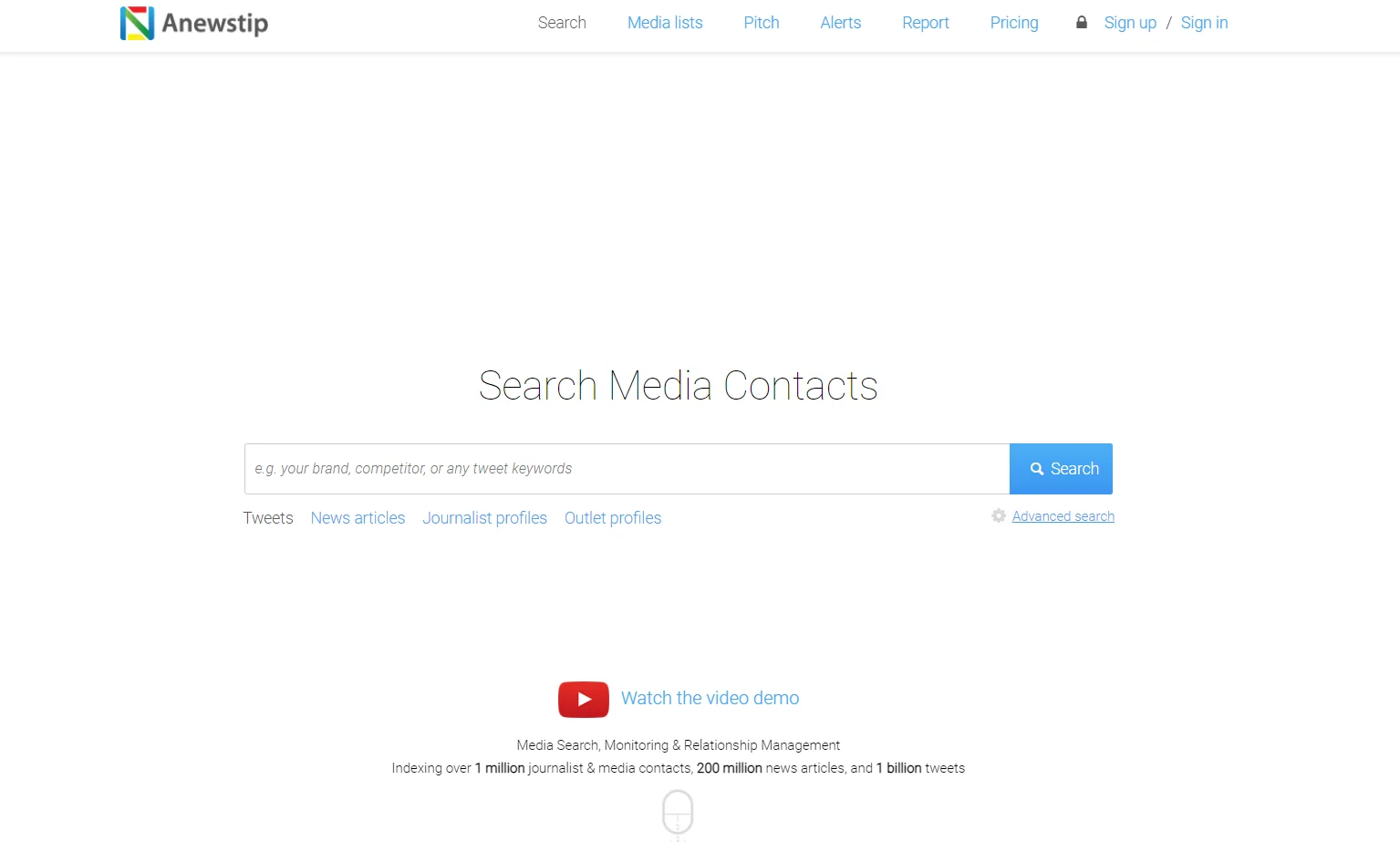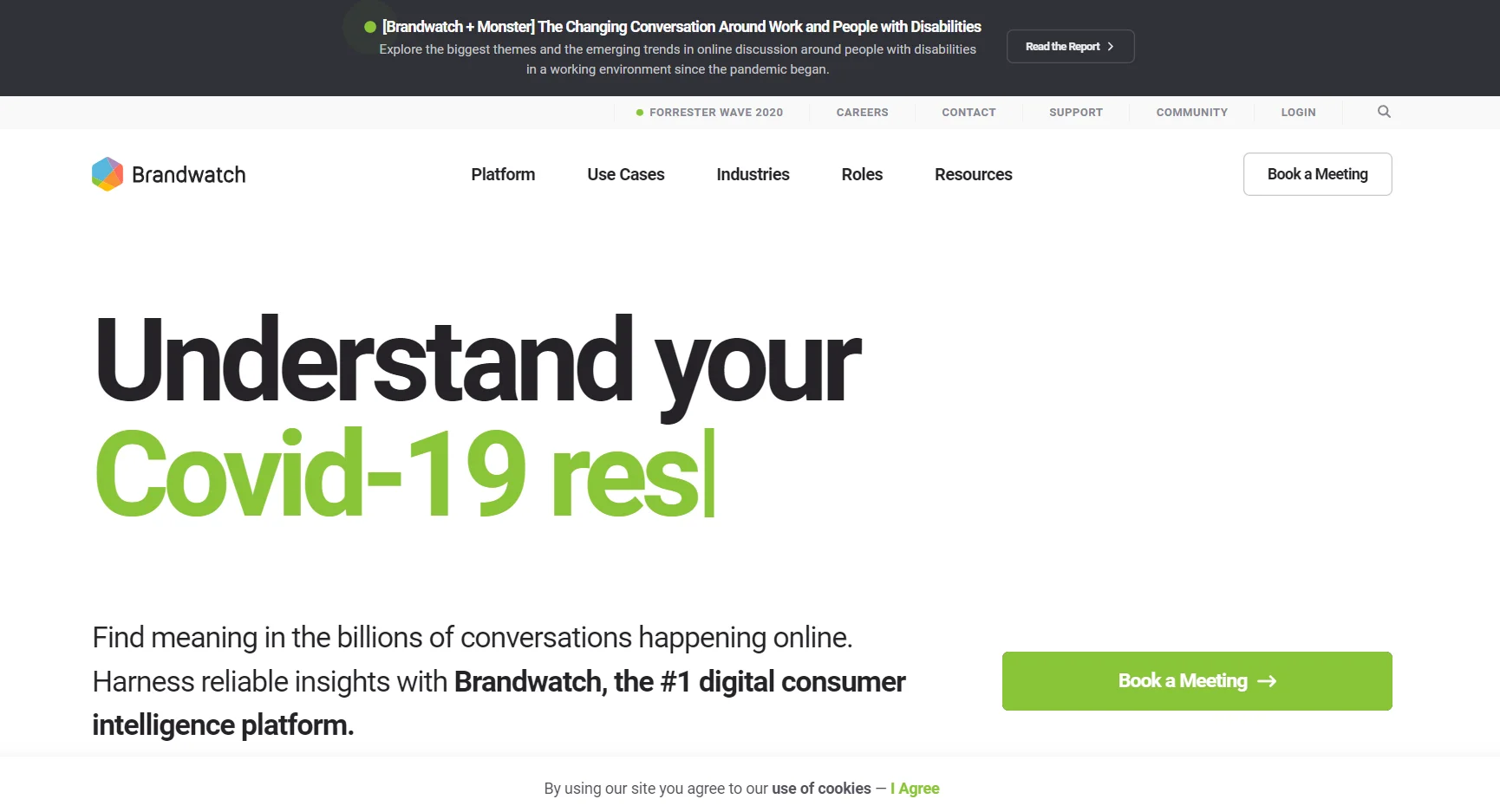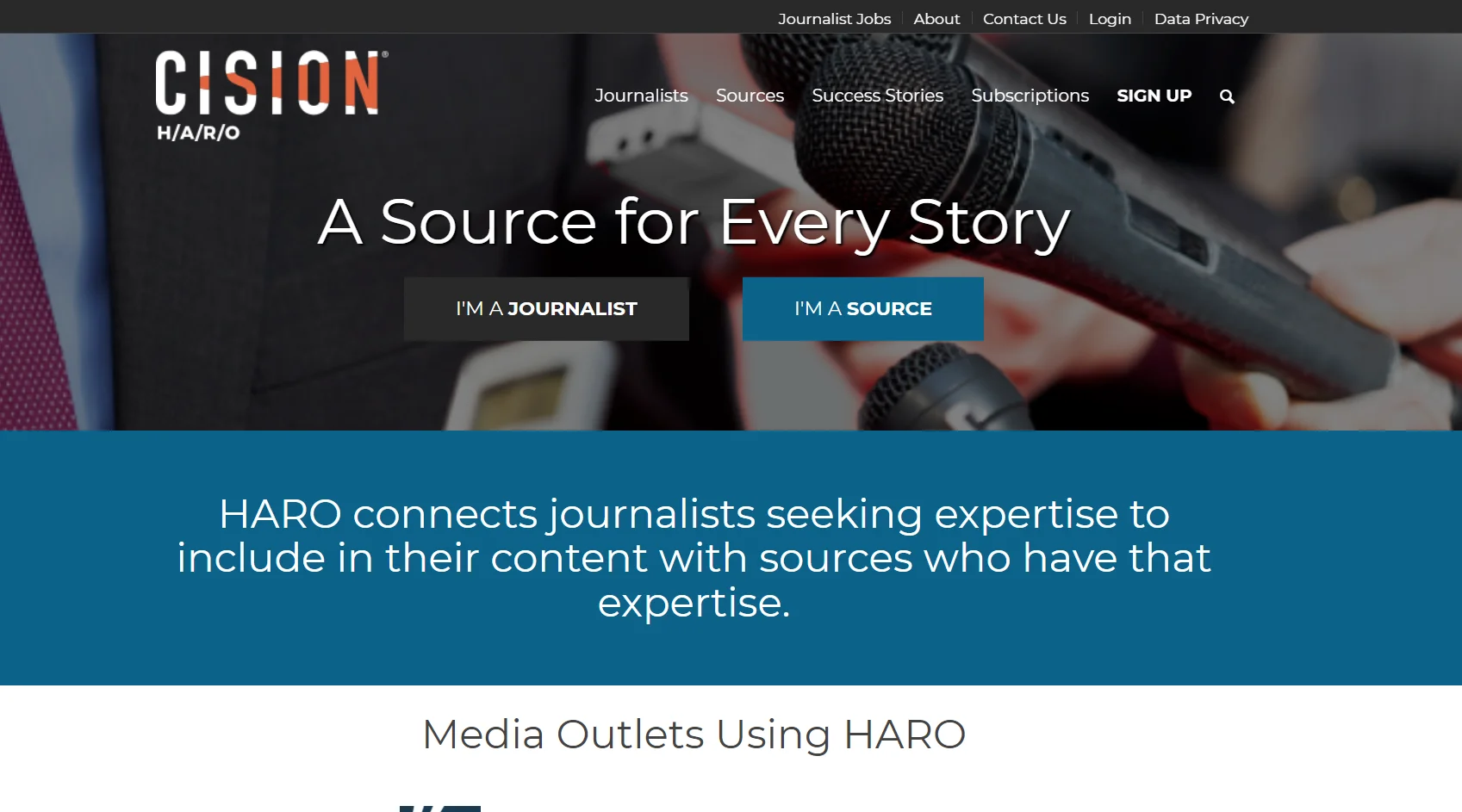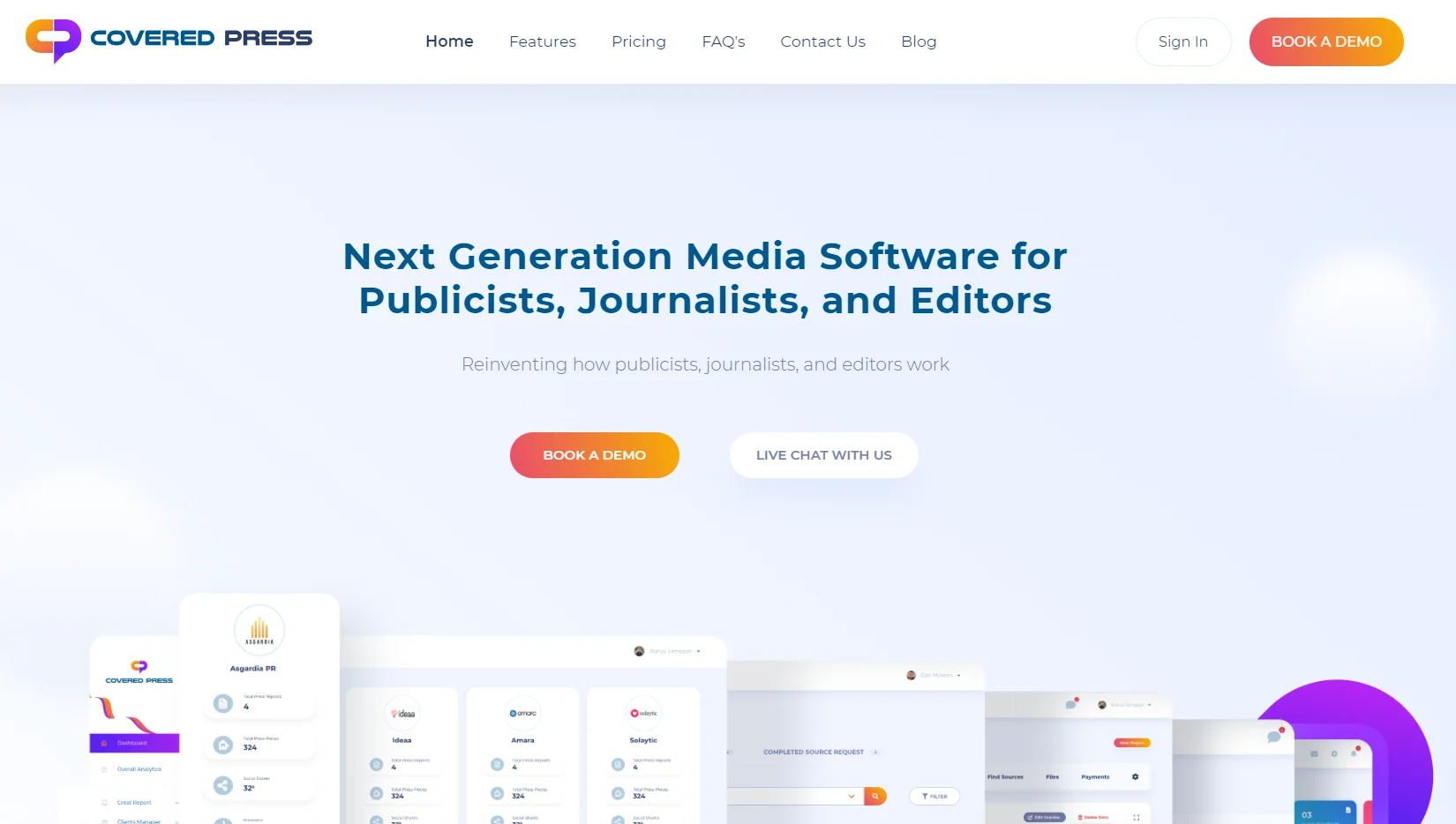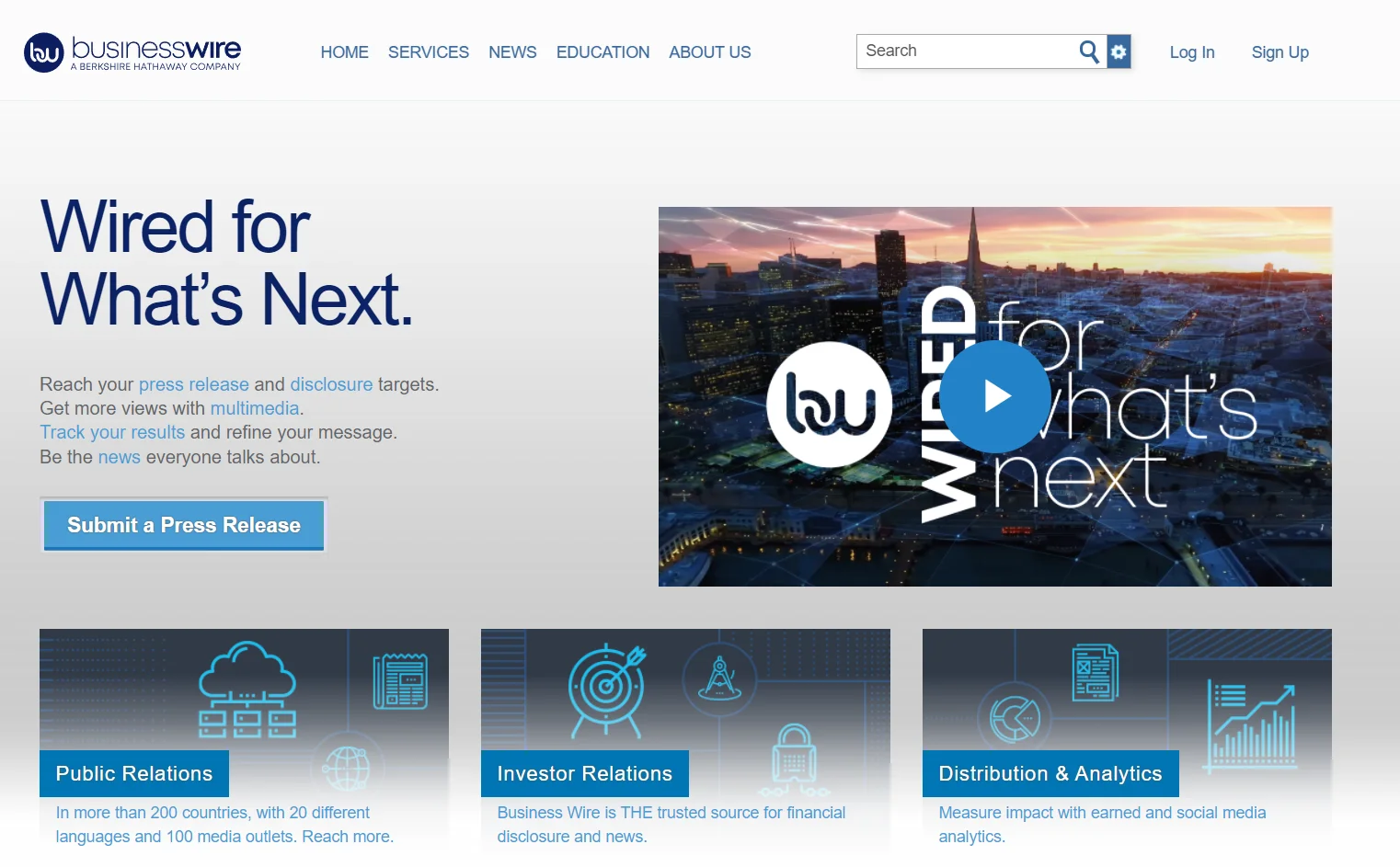 My Cart 0
My Cart 0
A variety of activities come under PR (Public Relations). Companies use PR professionals for the promotion of their brand image. Only a reputed agency plays a top public relations role. Having an effective PR managing department in your company can help you to monitor your customer’s reputations. PR promotes your business still it is quite different from marketing. This article will brief you about all the important aspects of public relations.
What is a PR firm?
A place where PR experts sit and manage the reputation of their client’s valuable audience is called a PR firm. If you don’t have a positive brand image then you will fail to achieve desired business goals. The main task of PR firms is trust builds up between your company and its customers. The PR firms specialists use organic methods to spread brand awareness among the audience. Before you start with any PR service you must know what is a PR firm?
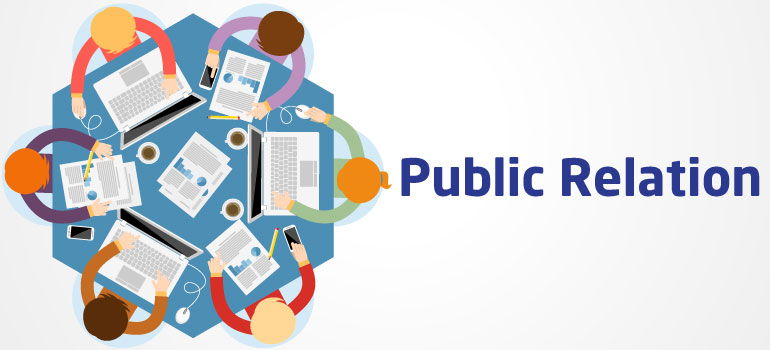
Blogs/ writing editorials, events, social media, and other traditional methods are used by public relations firms. Experts of such firms are skilled in building a positive brand image by following some steps and making strategies. They first do proper study and analysis on your company, its competitors, and customers. After that, they create a roadmap and go accordingly to spread positivity at a broad level.
What services does a PR firm offer?
By utilizing research-based methodology and strategies, many reputed PR firms are doing a vital job for businesses. Below are a few services that a PR firm offers:
1) Media relations:
This is the best platform to keep your stakeholders and customers engaged with your company stories. As a businessman, you have many things to do. Also, it is not always possible to have good contacts in media. Your PR firm helps you in building and utilizing media relations very well. For that, the experts spend their quality time and find out the right people to express your business story. Under the supervision of the PR team media relation, experts place press releases, radio appearances, and more. People from media relations make your business stories newsworthy and allow you to take advantage.

2) Strategy development:
Many people still don’t know that what a PR firm does for brands. As a businessman, you know that different people have different opinions about a product or service. But the social media have the power to attract a maximum percentage of the audience. But it is not that easy for everyone. Only experienced people from PR can develop a reliable strategy. They plan and execute as per your brand requirements. Timely coordination with respective departments, building media relations, and planning events give weight to your brand.
3) Content marketing:
PR firms work for various types of companies. So, the level of their knowledge is very high. They know the best utilization of content marketing services. They choose this cost-effective way to boost your brand image. PR firm services are popular for using unpaid, organic content marketing services. By selecting the best fitment to your brand image, they create engaging content. By understanding the criteria of your audience, they categorize the type of content. It can be fun-based as well as informative. Also, it can be a combination of both. PR experts also make sure that maximum people read and share the content to increase the chances of popularity.
4) Event coordinating and experiential marketing:
This is human nature that they prefer the brand that they experience once. Agents from the public relations team are masters of all the tricks to attract a maximum audience in a short duration and less investment. To make people more familiar with your product they organize experiential events. This is the most entertaining way to engage people and promote your brand. They coordinate with various important channels to ensure the success of their organized campaigns.
5) Releases Spokesperson Training:
A person who directly interacts with media to explain your company stories needs to be excellent. PR firms offer a world-class spokesperson training program. They train the person about the brand and public interaction skills. These days spokesperson promotional activities are in trend and easily attract audiences.
6) Thought Leadership:
If you are looking for increased credibility then thought leadership by PR firms can help a lot. Company public relations work with different tactics to create and share thoughtful business ideas. They create provoking content that can work for different types of businesses. It helps you to improve your leadership command over your business.
7) Social Media Management:
PR firms are highly adept at using various social media platforms perfectly. They do extensive research and find potential social media channels. By planning online events and sourcing resources, they polish your brand reputation. Even public relations works very well in providing training to your company staff to handle social media in the favor of your brand image.

8) Reputation Management:
Negative reviews and poor-quality contents are some reasons which can affect your brand reputation so badly. Sometimes when your website goes response less for a longer duration than also you lose trust and popularity among your audiences. PR firms are always there to handle such situations. They effectively work on negative reviews and improve the positivity all around. Their solid reputation management strategies work as an asset to your brand.
What do Exactly PR Firms do?
PR companies promote brands through editorial coverage with the support of social media, newspapers, TV, and magazines. These PR services are completely opposite to advertising agencies. Let us see what PR firms do for the promotion of individuals or brands.
a) Research target market and personas:
PR firm has experts who are skilled with tried-and-true methods to target market and persona. Their effective and intelligent marketing strategy helps in creating an audience persona. So, if you have the question that what does PR do? then read the entire content thoroughly. People love to interact with a brand that talks with its audience. Targeting at the wrong place will waste your time and money. PR experts find out the right market and right audience and do focused targeting. Public relations firms create a strong audience persona by using user research-based information.
b) Create targeted press lists:
Public relations work in below mentioned 5 important steps for press lists:
1. Defining the target audience
2. Finding media outlets and journalists
3. Preparing a list format
4. Adding contact information
5. Updating media list regularly
c) Create compelling pitches:
The public relations team does deep research on the journalists. They read their articles thoroughly. Also, they include a personal twist and context to create compelling pitches. The PR team creates short personalized messages that explain why it needs to get published. A boring subject line never works. Only experts know how to create catchy and engaging pitches, that is the reason why we need company public relations firms.
d) Conduct outreach:
PR outreach is also known as media outreach. Following steps are performed by the team to conduct outreach:
1) PR outreach plan preparation:
According to the client’s business size, type and other aspects experts prepare a plan for outreach.
2) Meeting with journalists:
The PR team makes efforts and spends time reaching out to the media experts. After finding the best one they introduce the business to that journalist.
3) Use of tools:
For a successful outreach, they follow a few steps and use outreach tools. BuzzSumo and Klear are a few tools to support outreach. These tools are so user-friendly and help to get influencers. Stagewise many other tools are used by the PR firms to conduct outreach.
4) Experiments:
After they are done with making an outreach plan, they start doing PR experiments with different content and channels. One thing that they avoid is mass pitching. As a beginner, we can make mistakes as we don’t know the value of research. Public relations experts define only relevant information based on the deep study results.
5) Timely action:
Timely pitch is again a matter to look seriously. Delays will affect your overall outreach plan.
6) Structure:
Once all the above steps are done, the public relations role gives a proper structure to their pitch.
7) Patience:
The last but not the least thing is to be patient. As we all know that relation-building takes time. But stepwise outreach conduction gives the best results under a short waiting time. In short, it works everything that a PR firm should do for you?
e) Coordinate and handle trade show opportunities:
Trade shows are very popular for decades. Such shows bring opportunities for business and help in building worldwide relations. The area of promotion depends on the type and size of your business, the platforms you choose, and your budget. PR firms can handle trade show responsibilities effectively by following below mentioned steps:
1. PR team sets goals of the trade show
2. They book the most suitable venue
3. Choosing perfect timings for a trade show to gather a maximum valuable audience is their next step.
4. PR team invites relevant media for promotion and telecast of the trade show.
5. Also they offer refreshments during the trade show to hold the audience till the trade show ends.
6. Experts make people know about your trade show with the help of social media.
7. Thumbs up! All is set for the public relations trade show
f) Handle all aspects of influencer relations:
Today public relations role independently works as influencers. All that happens due to their expertise and skilled performances. According to PR agencies, great content is the key point of building relations. If your content is appealing then only your audience will read about your business story. Also, the strong exposure is the strength of PR agencies that make them superior in public relations. They are also known for their quick and proactive response.
Conclusion:
You must have got the answer to how does PR works. It performs as full-service agency for businesses. These firms take the responsibility to spread desired awareness and create a positive brand image. Without the support of these experts, it is quite impossible for you to reach your success goals. For your business, PR firm services are like an in-house CMO. PR experts bring a wide platform where your brand grows every minute. So, utilize their expertise, execution, and strategies to elevate the value of your business.
Investor relations firms are an integral part of how a particular public company works. They essentially collect, prepare, and report the necessary data by communicating extensively with the CEOs, lawyers, and accounts team. An investor relations firm should not only have great communication skills but should also be knowledgeable about the legal and financial terms and conditions of a company. Hence, the need for a competent investor relations firm is crucial. Again, finding the suitable one is quite difficult due to the huge list of options available. Since different companies operate differently and look into selected matters, you need to choose the company very carefully and consider all your requirements.
To help you go past this dilemma, we have listed the top 20 investor relations companies in 2021 along with their core operating features. You can choose from this list according to your requirements.
1) Gem Comm:

Counted amongst the top international investor relations agencies, Gem Comm controls its operations from Singapore. They particularly specialize in investor relations, public relations, branding, marketing, and other crucial strategy building for clients across Asia, the US, and Oceania. Gem Comm understands how important communication is for businesses to grow and retain their relationships with clients, customers, stakeholders, investors, etc. Gem Comm with a strategic and proactive approach to communication helps them seize opportunities The firm also specializes in solving stakeholder issues and advice directly to boost the growth and development of their client company. The company has a 100% track record in helping clients achieve their goals. To accomplish this, they create and implement PR & media content, improve thought leadership & content marketing, and mitigate crisis and issues.
2) Berkeley Communications:

Berkeley Communications are one of the best international investor relations companies that have their headquarters based in the United Kingdom and several offices throughout Europe. They operate with clients across Asia, North, and Latin America. They help companies drive through the market and boost sales as a primary aim. Berkeley Communications also operates as a public relations firm when required. They perform extensive research and analysis of the market and competitor companies to help their client achieve new heights. They mainly deal in industries including IT, telecommunications, and e-commerce.
3) KCSA Strategic Communications:

KCSA Strategic Communications acts both as an investor relations firm as well as a public relations firm and operates directly from the United States. They develop market-class strategic plans; help to increase market visibility, boost sales and communication for their clients. They also undertake social media management for their customers and devise strategies for maximum reach through social media platforms.
4) ICR:
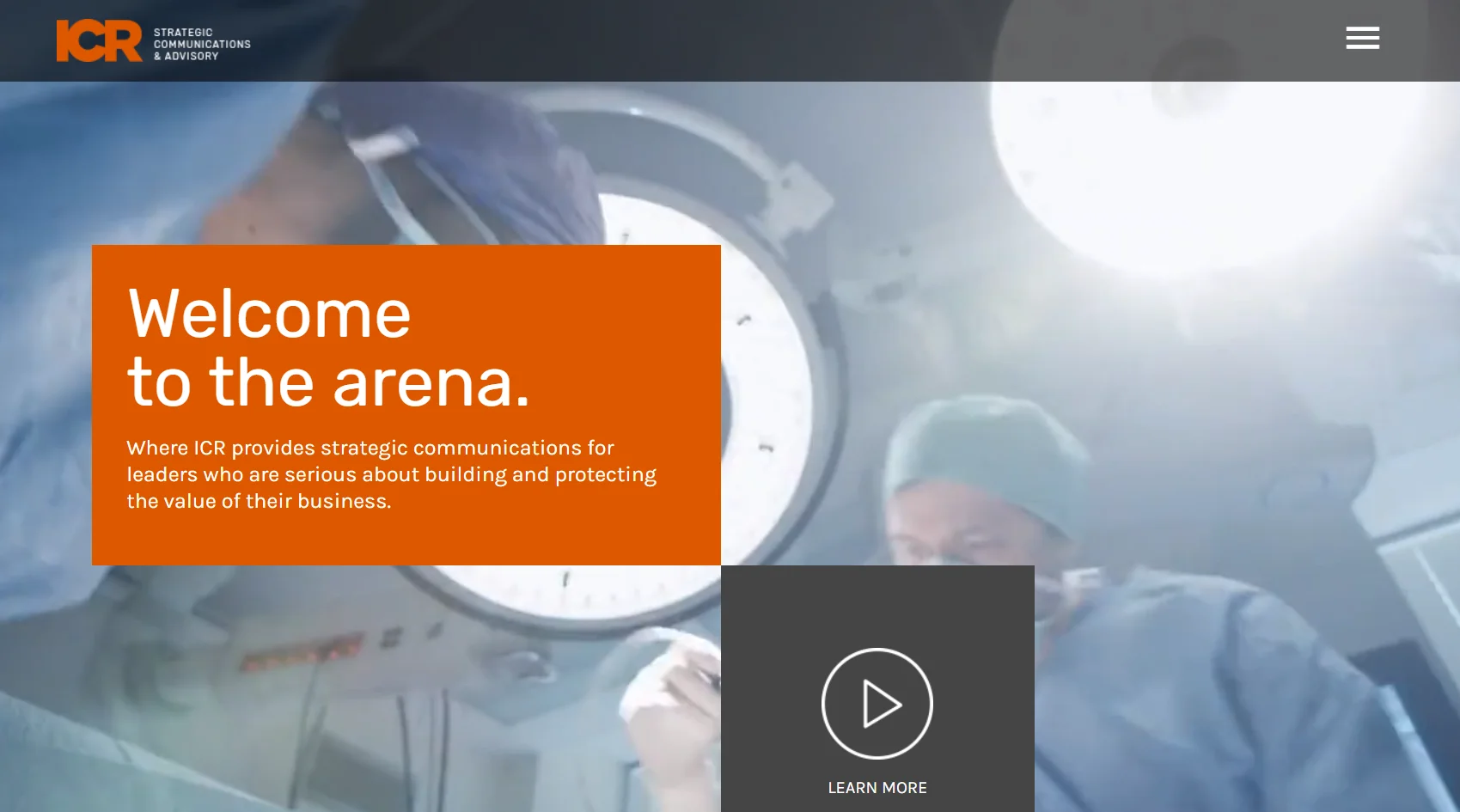
ICR mainly is an advertising company based across various states of the United States including New York, San Francisco, Los Angeles, and Boston. It is one of the oldest operating companies established in 1998. They work for their clients in a manner where they design their client’s websites in compliance with the terms and conditions listed for publicly held companies. They build a web platform for their clients and promote it. Side-by-side, they perform analytics and data management for their client companies and helps them meet their sales targets. They help companies that belong to the real estate, financial services, and energy sectors.
5) PINKSTON:
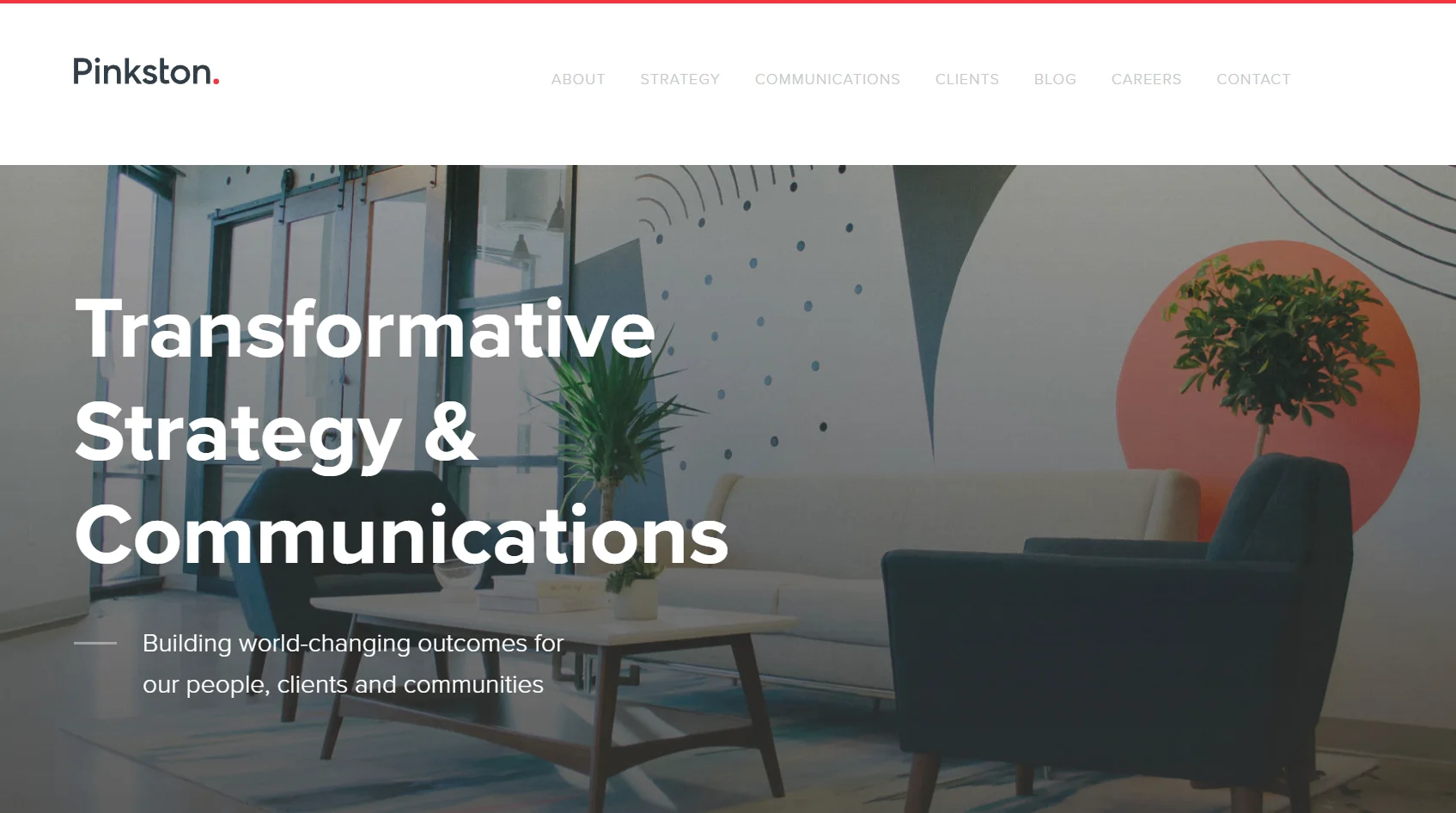
Another United States-based company, Pinkston Group is a notable advertising and public relations company founded in 2001. They mainly deal in public relations but also have expanded into providing digital strategy services and broadcasting services. Though a company of few heads, they are specialized in handling complex clients and have achieved worthy success since its inception. They help their customers with extensive reach through media and also help in communications within the market. They prefer to work directly with the CEOs and hence they can provide high-class and furnished results. They help non-profit organizations along with companies in the IT, telecommunication, medical, financial, and business services sectors.
6) BlueChip Communication:

BlueChip Communication is a marketing and public relations agency based in Sydney, Australia. They specialize in solving complex marketing issues faced by their clients. They deal with both small firms and large companies. They are also known for providing excellent content-creating solutions. They mainly work with companies that are part of the real estate, legal, and financial services sectors. They also provide extensive digital marketing services according to the needs of the client. They like to work with data where they analyze market possibilities, provide insights, and accordingly suggest solutions.
7) REQ:

REQ is a digital marketing and management solutions company based across several places in the United States including Washington DC, New York, Virginia, Boston, San Diego, and Las Vegas. They are pioneers in using marketing insights to bring brand awareness, reputation, and business results for their clients. They use modern technology and analytics to deal with companies in the IT, energy and resources, medical, retail, consumer goods, hospitality, and real estate industries. They serve internationally and have achieved various accolades. They build extensive digital marketing strategies for their clients and help them boost sales and increase their overall brand reach.
8) Elevate Communication:

Elevate Communication is a public relations and communications company founded in 2007 and is headquartered in Brisbane, Australia. They also deal in creative and strategic development services for companies across various industries including financial, medical, telecommunications, real estate, retail, and many more sectors. Elevate Communication excel in creating powerful social media marketing strategies to keep their clients highlighted on the social platform, building strong brand recognition for them. They also provide web development services whereby they optimize the client’s website for maximum reach.
9) June Communications:

June Communications, established in 2015 is a communications and marketing firm based in Bucharest, Romania. They deal in various services including public relations strategies, marketing solutions, digital strategies alongside content marketing services. They usually do not deal with large companies due to their employee capacity but have helped several small and medium companies gain success over the years. They use powerful strategies to help their clients communicate and build sales. They also provide solutions that help their clients leave a mark on the market. They mainly deal with companies that are in the consumer services, IT, medical, financial services, and business services sectors.
10) Red Fan Communications:
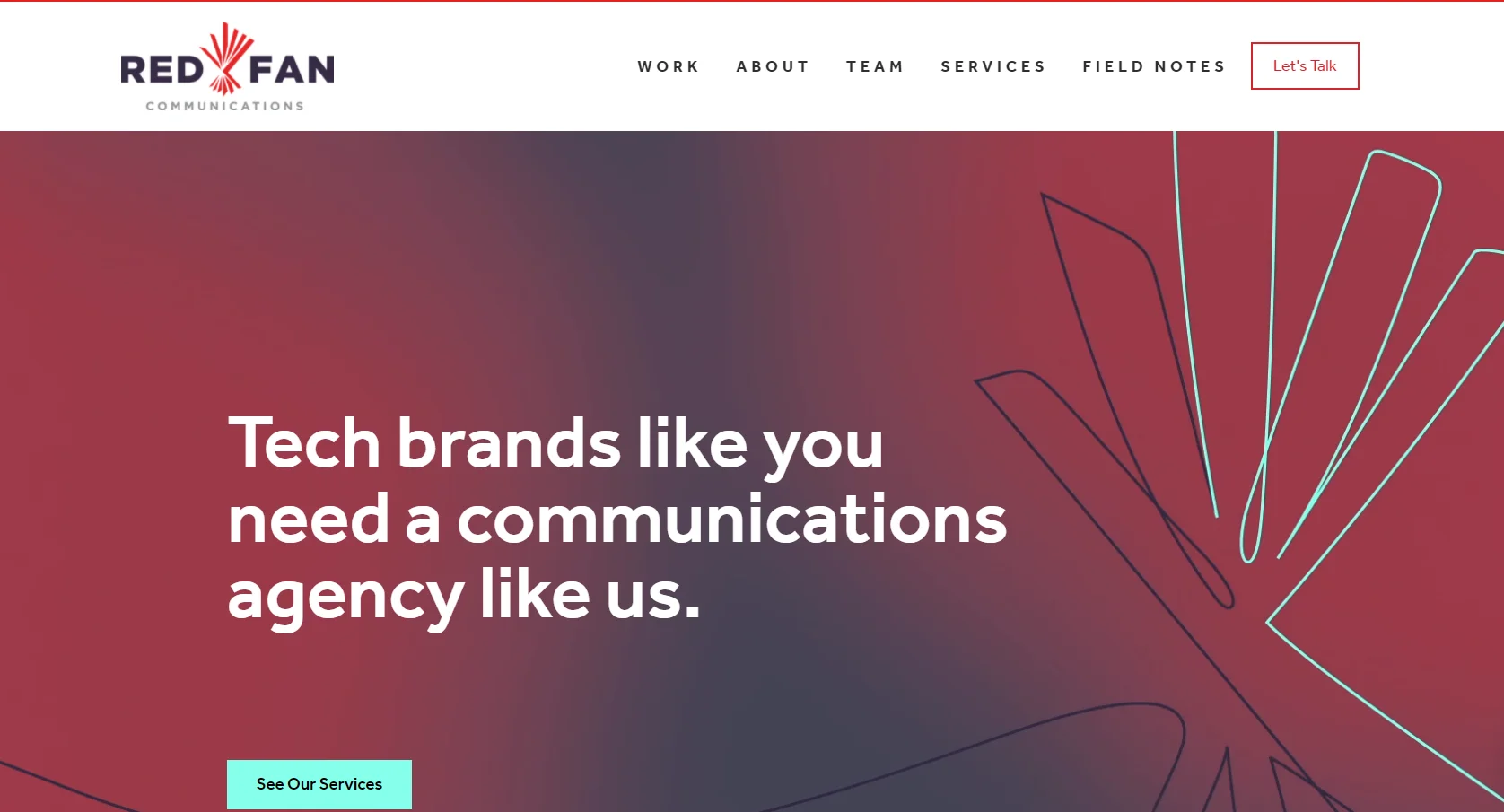
Red Fan Communications is a popular company dealing in public relations, branding, digital marketing strategy and consultancy. It was established in 2008 and has its headquarters in Austin, Texas, the United States ever since. Due to their employee capacity, they mainly focus on small and medium-scale companies and provide them with world-class marketing solutions. They deal with companies that are a part of the medical, education, IT, financial services, energy, legal and business services industries. They also assist in creating media content to keep their client on top for constant brand recognition.
11) OTC PR Group:

The OTC PR Group is a public relations consultant helping small capital companies to interact with the shareholder base. They are completely based in Florida, United States. They use the newest technology to communicate with and propagate the potential financial condition alongside the corporate vision of their clients to investors and stakeholders for the development of business and promote the same to the media for brand recognition. They also deal with digital marketing and portfolio management and devise a certain set of targets for the right investment.
12) BDC Consulting:

BDC Consulting is a small company that was founded in 2011 and operates from Minsk, Belarus. They mainly deal in marketing services and consultancy and work with medium-scale companies. Apart from their core services, they also provide SEO services, public relations and marketing strategy development. They focus on companies within the financial services and e-commerce industry. Alongside providing SEO solutions, they also manage content creation and social media management services for various companies. They use insights and extensive metrics to glide through the market and increase their client’s brand awareness.
13) NEFF:

NEFF is a multi-operational company operating from Philadelphia, United States. They deal in operations like public relations, branding, social media management, website designing and optimization, web development, media strategy services, advertising solutions, photography, and videography. They operate across various sectors including education, real estate, sports, financial services, and more. They use special technologies, integrated strategies, and personalized marketing solutions to build and facilitate relationships between your brand and target audience.
14) Trizcom PR:

Trizcom PR is one of the best public relations and investor relations consulting firms based in Dallas, United States. Established in 2008, they are a team of very few employees, known for their best outputs. Apart from core public relations, they deal in social media marketing, SEO optimization, content marketing services, and digital strategy services for major companies. They have helped several big and small companies with their website optimization and elevating their social media presence and general media presence. Their broad spectrum of services extends across various industries like education, real estate, and financial services.
15) Bebop Asia:

Bebop Asia is one of the leading public relations firms in Asia based in Singapore and was established in 2010. It constitutes a small team of professionals that deal in content development for SEO, link earning, on-site development activities, mobile optimization services, media management alongside public relations services. They aim to help their clients get recognition throughout the Asian market and help them with enhanced brand exposure.
16) Swyft:
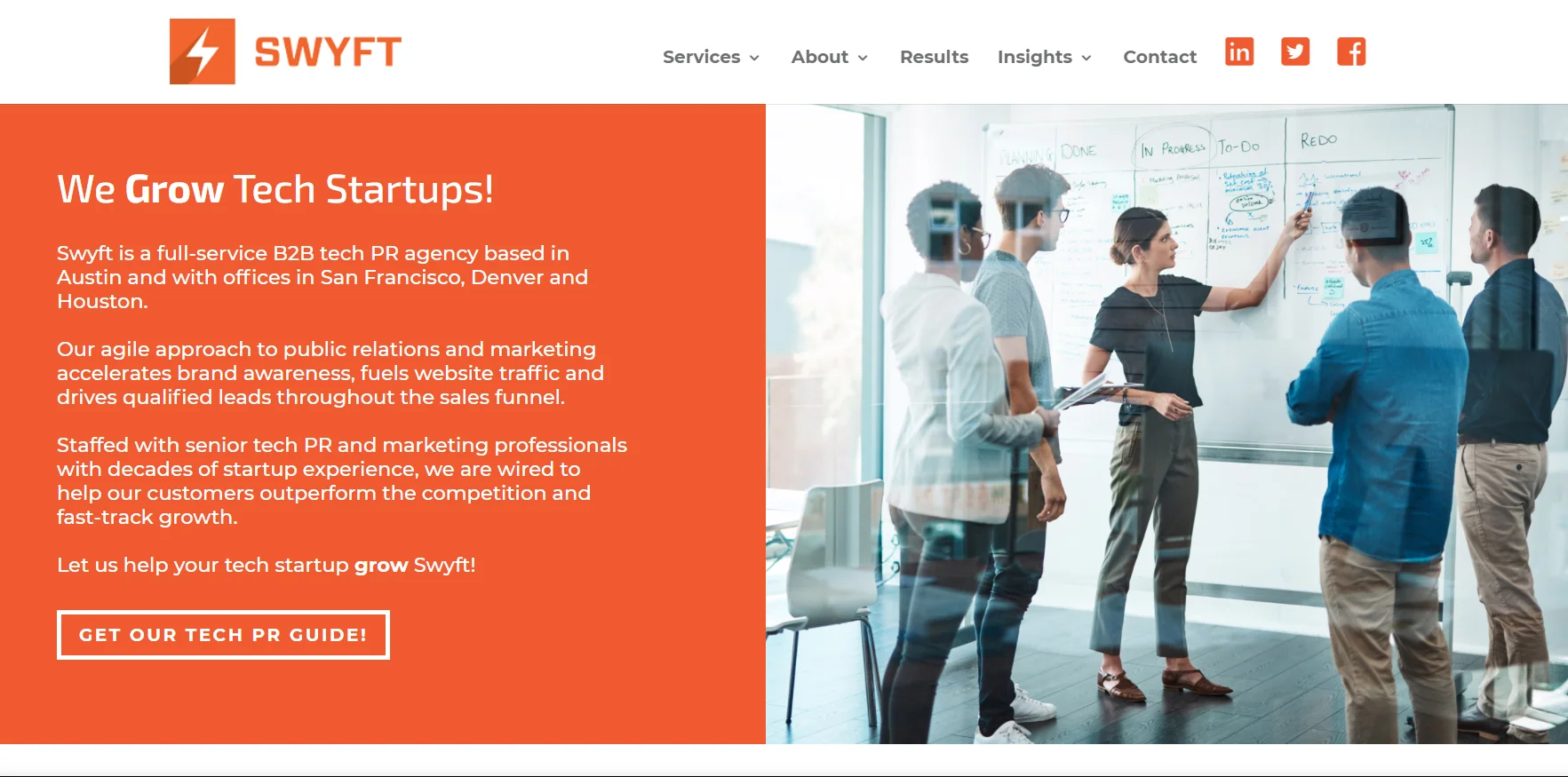
Swyft is a multinational marketing and public relations agency that was founded in 2010 and is based in the United States across Austin, Denver, and Houston and in Antwerp, Belgium. They deal in core public relations services, content marketing, and web designing services. Through their content development campaigns for their clients, they help brands gain maximum social exposure and high website visits. They mainly target companies in the real estate, financial service, marketing and sales, and legal sectors.
17) Oggadoon PR and Digital Marketing:
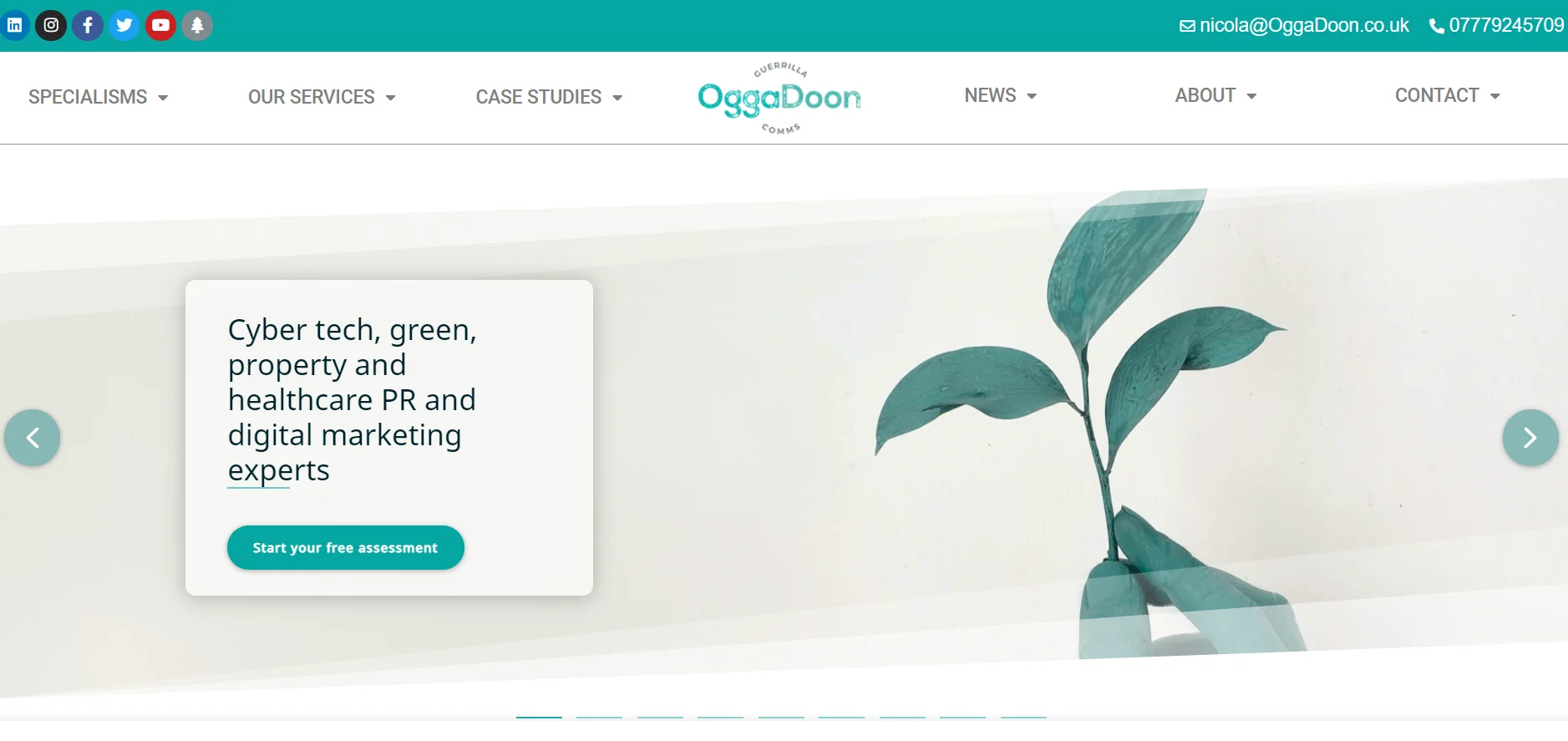
As the name suggests, Oggadoon is a public relations and digital marketing assistant firm that was formed in 2012 with its headquarters at Bristol and another branch in London, United Kingdom. They are known for their high-end digital marketing services and assist in content marketing and social media marketing. The firm mainly deals with small and medium-scale companies, managing their media exposure alongside building communication within the market. Their expertise is within the business sector, energy, real estate, IT, telecommunication, media and medical industries.
18) PRLab:

PRLab is a public relations company based in Amsterdam, the Netherlands and has been operating since 2018. Besides their core public relations services, they also serve small and medium-scale companies with avant-garde content marketing solutions. Their target industry mainly lies in business and financial services, e-commerce, manufacturing, retail, and IT. They arrange for outreach campaigns, handle content research and generation, and promote brands through social media marketing.
19) ZCorp PR and Digital:

ZCorp PR and Digital is a public relations and digital marketing services company with its presence in Melbourne, Australia and Florida, United States. They serve a lot of departments including SEO development, pay-per-click solutions for client websites, digital strategy making among others. Apart from that, they provide automation solutions too.
20) Tribe China:
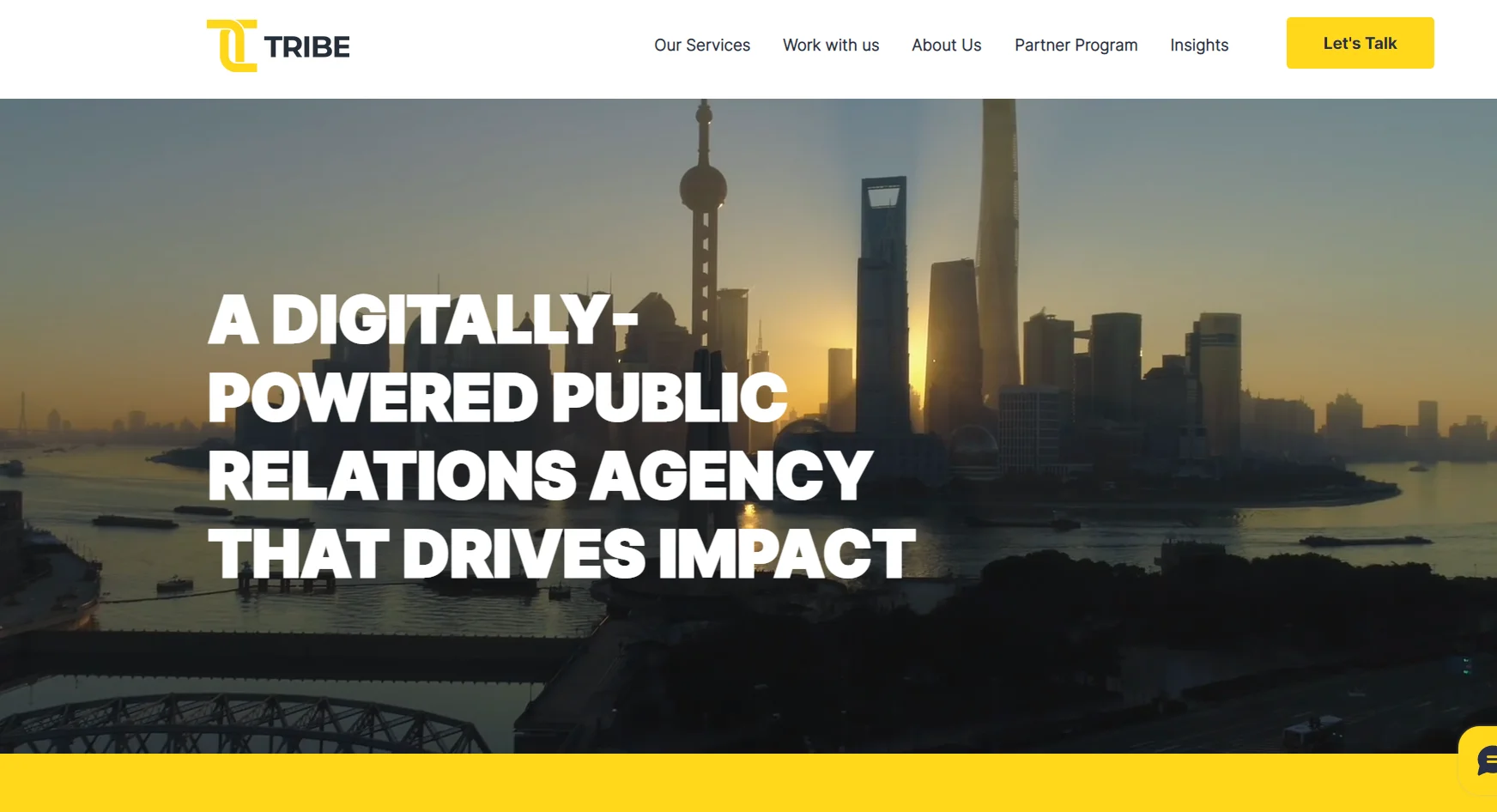
Tribe China is a core Public Relations Company headquartered in Shanghai, China. Apart from its core public relations services, the company also deals in solutions related to social media marketing and content marketing. Their digital content marketing strategies have helped a lot of brands with the desired promotion and limelight. They mainly deal with companies in the IT, energy, consumer products, and retail sectors. They also serve certain domestic non-profit organizations, helping them to engage with the masses while creating overall brand exposure for them.
It’s time to identify your requirements and collaborate with the most suitable firm from the above list.
Saving Money: Shopping Habits
When it comes to saving money, Holidays can get a little tricky.
Here is some ways you can save.

-
Buy in bulk: Buy your daily used item in bulk at wholesale stores. Buy bulks during huge sales such as (black Friday sales, 11.11, etc)
-
Shop secondhand: Explore eBay, thrift stores, etc, and only get items you need.
-
Buy less: Buy fewer items, and focus on purchasing items of higher quality. As quality items cost lesser per use than items of a lower-priced as they last longer.
-
Compare prices: Survey the price of an item you need across the different platforms to get them at a lower price. When shopping online, always check for points or use coupon codes.
-
Borrow instead of buying: Borrow items instead of purchasing items that you might not need in the long term. Like Books, Clothes, Equipment & Tools, etc.
-
Make a list and stick to it: When you go shopping you will have a tendency to stray out of what you need to get. Building a list and planning the route allows you to keep track of what you need to get and sticking to it will help reduce overspending.
About GEM COMM
We are an International Investor Relations firm (IR) based in Singapore. We specialise in Investor Relations, Public Relations, marketing, branding and messaging strategies for clients that include organisations of all sizes across Asia, Oceania and US.
GEM COMM advice and solves stakeholders’ issues, drive growth, reposition your business, improve your marketing and Public Relations (PR) or engage with investment community in your leadership or strategy story. We have a track record of helping clients reach these goals. We create and implement PR & media content, mitigate crisis and issues, establish and improve thought leadership & content marketing.
GEM COMM Engagement types include:
- IR/PR retainer program
- Crisis and issues projects;
- Content marketing (from research to lead generation) inclusive of Press Release drafting, Media Pitch, Website content, etc.
Building trust and relationship with the public are quite essential if you want to run a successful business. Better known as public affairs or public relations, it is the process of connecting with people at large through various means of communication be it online or offline. Its purpose being distribution of information, shaping public opinion, and ultimately gaining publicity for your brand and business.
News media naturally plays an integral role in managing your public affairs due to its wider media coverage. In fact, media, both traditional and digital, is the key to creating a positive image of your brand in the market. It’s the main channel for if you want to get your word out in a favourable manner. And hence the term- media relation!
Now being at the core of public relations, media relations is often used as an interchangeable term to describe the former. But which isn’t entirely true! Media relations, although an integral part of public affairs, is just one way of addressing your audience. Whereas, public relations is the umbrella term for all the ways you could use to send a message and inform the masses.
We shall talk more about the major differences between public relations and media relations, but first let’s take a closer look at both the concepts separately.
What is Public Relation?
Public relations, or public affairs is the process of interacting with the public via different modes of communication in order to create or affect your public image. It is usually maintained by releasing newsworthy information on topic of public interest and current trends that benefits both the company and the consumers.
Some of the common examples of public relations include investor relations, customer relations, media relations, and community relations.

What is Media Relation?
Media relation on the other hand is mainly to do with interacting with people from the media or the press. This includes connecting with editors, reporters, and journalists from all kinds of platforms such as radio, television, newswires, and social media. One of the most common and popular ways of doing that is by releasing a press release to various news media channels.

Media relation is undoubtedly the most effective and far-reaching aspect of public relations due to its wider reach. Its goal being able to convey your message or story in an appropriate and intriguing fashion to a larger audience base at once.
So public relation is when you want to address or inform the people as a whole, and media relation is when you specifically connect with news media so as to get an even wider coverage on what you have to say.
On that note, let’s go through the key differences between media and public relations without any further ado.
Media Relation vs Public Relation:
| Public Relation (PR) | Media Relation (MR) |
| 1. Public relation uses multiple channels to give you the public exposure. | 1. Media relation is just one of them. |
| 2. PR is the rectangle: All public relations are not necessarily media relations. There are other types of public relations such as investor relations, government relations, community relations, customer relations, and media relations. | 2. MR is the square: All media relations are public relations. It is just a subset of PR. |
| 3. Public relation shapes the message. | 3. Media relation spreads the message. |
| 4. Public relations achieves success in many ways. | 4. Media relation is one of its achievements. |
As you can see, public relation is a vast process of building trust and loyalty between brand, and consumers. Whereas media relation is just one of the ways of accomplishing that. Nonetheless, media relation is one of the most efficient marketing communications technique that you could use for a number of reasons. Let’s take a look:
Benefits of Media Relations:
Press or media has always been a powerful tool when it comes to effective communication and for all the good reasons:
1. Better media coverage:
In this age of information when half of all the internet is occupied by fake news, independent journalism, pop-culture, and conspiracies, it’s always useful to have your story or message published in a legit way by an authentic news agency. Plus, you’d get a wider coverage with it than any other means of communication.
2. Increased brand awareness:
Media relations are also quite efficient when it comes to increasing your brand’s awareness in the global market. You can use them to convey information about your company, its values and practices, upcoming products and launches, special events, community service, or anything that is newsworthy or of public interest.
What’s more is that most media outlets can look for multiple places to publish or broadcast your story starting from newspapers, newswires, websites, blogs, podcasts, television stations, radio shows, and so on. A variety of these different modes further help increase your brand awareness while addressing your actual targeted audience.
3. More credibility:
Getting your message delivered to the public by a trusted media outlet can also put a lot of substance into your story. Besides, most consumers tend to stay loyal to companies they trust. The same goes for media outlets. Any news agency that has established this trust is most likely to win the loyalty of its consumers for your brand or business, which is a win-win for all!
4. Strong media relations:
By being in touch with media personnels on constant basis, you can build your own network of trustworthy media partners who when the time comes can help you with valuable insights into current trends and topics. And if your stories are captivating enough, they might as well approach you as a source rather than going to your competitors.
5. Crisis management:
Crisis management is yet another critical aspect of public affairs that has to be dealt with carefully. Hiding a crisis from the public, or the investors is never a good idea! And that’s where media relations come into picture as a humble way of informing the public about what went wrong, what kind of crisis is it, and how long or what measures you’re going to take to control it in timely manner.
So media relations, as you can see, is not only limited to reaching out to more public, but goes far deeper in shaping the over-all publicity of your brand which is the ultimate goal of media relations in public relations as a whole.
Benefits of Public Relations:
To be able to create and maintain a favourable public image for your brand is quite an achievement in itself. But an effective public relations campaign is much more than that. If done right, it could accomplish a lot more than just publicity, starting from meeting your business goals to getting out your messages right.
Here are some of its key benefits:
1. Credibility:
Since public relation is more to do with providing newsworthy content than direct marketing, it naturally boosts the over-all credibility of your brand in the public as a customer-friendly business than money-oriented. Moreover, modern consumers are too smart and cautious about where to spend their money, and eventually tend to show more confidence to companies that manage their public affairs through credible sources.
2. Target Market:
Attracting and retaining a target market is of great importance if you want to succeed in your business. A well-placed PR campaign can do just that by placing your products, services, and information in various places pertaining to those target markets.
3. Brand Image:
Brand Image is always at the core of public relations. Contrary to marketing which is mainly to do with selling a product or service, public affairs is a delicate business of creating and maintaining a positive and long-lasting image of your brand in the market. A positive perception of your brand would further help you gain trust, loyalty, and confidence from your existing customers and well as new prospects.
4. Short and Long-term goals:
Public relations can be used to meet both your short-term as well as long-term goals. Whether it’s about increasing the visibility of your brand, or offering valuable insights about your business practices, whether it’s about building strong relationship with the community, or giving more value to your clients, public relations is always at the forefront of any business strategy.
5. More value for customers:
PR can also help you offer more value to your customers in many ways. For instance, personalized e-mails about upcoming offers and order placement, assistance with sales process, post-sale customer care and so on.
All-in-all, public relations is a broader concept that uses various means of communication at its disposal to help you create and maintain a positive outlook of your company. Media being the primary tool to convey and transmit the information of public interest which in turns helps the company. So it’s more like establishing a mutually beneficial relation between a company and the pubic. Let’s take a quick look before we end this topic.
How do Public relations and Media relations work together?
As it must be evident by now, media relation is a part of public relations which revolves around making a brand famous and popular by means of press or the media. Although public relations aim at the same goal i.e. publicity, it may use other means of communication along with media, such as online communities, company’s website, and so on to spread the message.
So whether or not to use the media for managing your public affairs depends totally on your business objectives and the type of informationpublic relations vs media relations you want to release. Once you have specific goals in your mind, you can start considering the type of public or media relations strategy that’s more likely to succeed.
Hope this article would help you draw a fine line between public and media relations without mixing the two.
Saving Money in Your Daily Life
When it comes to saving money, your day-to-day expenses make a huge difference! Here is some way you can start!

- Set a monthly Budget: Use spreadsheets, budget software, or old-fashioned pen and paper to plan incoming deposits and outgoing expenses. Once you have Set your budget goal make sure to exercise the discipline needed to stick to it. (Refer to our Instagram post for previous methods that go along with this)
- Track your spending on an ongoing basis: Schedule a time and day each week to compare your actual spending in the month against your budget. By doing so it allows you to track where you can save on and ensure you do not overspend.
- Pay for day-to-day expenses with cash: Evaluate your monthly budget, and determine spending categories you. Determine what spending categories you can switch to cash-only payments (Entertainment, dining etc). While card/ online payments can tempt you to make impulse purchases and using cash helps you stick to your budget because it limits the amount you can spend on hand.
About GEM COMM
We are an International Investor Relations firm (IR) based in Singapore. We specialise in Investor Relations, Public Relations, marketing, branding and messaging strategies for clients that include organisations of all sizes across Asia, Oceania and US.
GEM COMM advice and solves stakeholders’ issues, drive growth, reposition your business, improve your marketing and Public Relations (PR) or engage with investment community in your leadership or strategy story. We have a track record of helping clients reach these goals. We create and implement PR & media content, mitigate crisis and issues, establish and improve thought leadership & content marketing.
GEM COMM Engagement types include:
- IR/PR retainer program
- Crisis and issues projects;
- Content marketing (from research to lead generation) inclusive of Press Release drafting, Media Pitch, Website content, etc.
“Whoever controls the media, controls the mind.”
A quote that quite aptly describes the crucial role that media plays today. Due to the increasing influence of media, over most of the choices people make, it has become mandatory for organizations to have positive media coverage. However, with social media platforms becoming a rage, consistent monitoring of these channels is also important to make sure you are sharing the right things with your clients. Today, you will find many tools specifically designed for PR activities that analyze reports, monitor your stories, and send pitches. This article highlights some of these PR monitoring tools to ease out your workflow.
Media Relations v/s Public Relations:
Media relations is propagating to the public; the missions, policies, practices of an organization through media. The goal of this is to create a maximum positive outlook in media about the organization, without paying for it through advertising. On the other hand, Public relations is a term often colloquially confused with media relations. There’s a subtle difference between pubic and media relations, however.
Public relations extend beyond media to the general public whereas media relations involve company relationships with journalists. The organization and journalists both are benefited from media relations. Institute of Public Relations in the USA defined Public Relations as a deliberate, planned, and sustained effort to establish and maintain mutual understanding between an organization and its publics.
Media Monitoring:
Media monitoring is not only useful to startups and small enterprises but also to large businesses. Media monitoring is basically being aware of what opinion others hold of your brand, competitors, and anything that affects your organization. In the past it was more of a cut-paste job wherein articles from newspapers were cut and pasted into clipbooks. Today, the software has replaced scissors. There’s the use of machines, processors, algorithms etc., making the task more refined. In simple terms, it could be listening acutely at all times. It could be done on social media platforms, broadcast, print, and online. It makes use of news monitoring and media tracking to create an impact.
It helps understand the customer base, know the brand perception and reputation, help mitigate risks, and help in better decision making by evaluating efforts.
There are three broad categories of media monitoring:
♧Free or cheap options
♧Paid media monitoring tools
♧Premium monitoring services
PR Tools and Their Importance:
Public Relations professionals make use of various tools including speeches, special events, news, brochures, audiovisual materials, logos etc. to create brand awareness. However, the use of PR monitoring tools has been known to manage your company’s media relations the best.
Public relations tools can convert interested consumers into loyal customers by persuasion tactics and creating positive attitudes regarding the brand. They are cost-effective and highly pay off, and ensure that your agency’s visibility and image across the market improves. They not just manage and track your clients’ efforts but also your own company’s PR efforts and help you garner the required publicity.
22 Best PR Tools For Monitoring Media:
A) Muck Rack (A GPS to look for journalists):
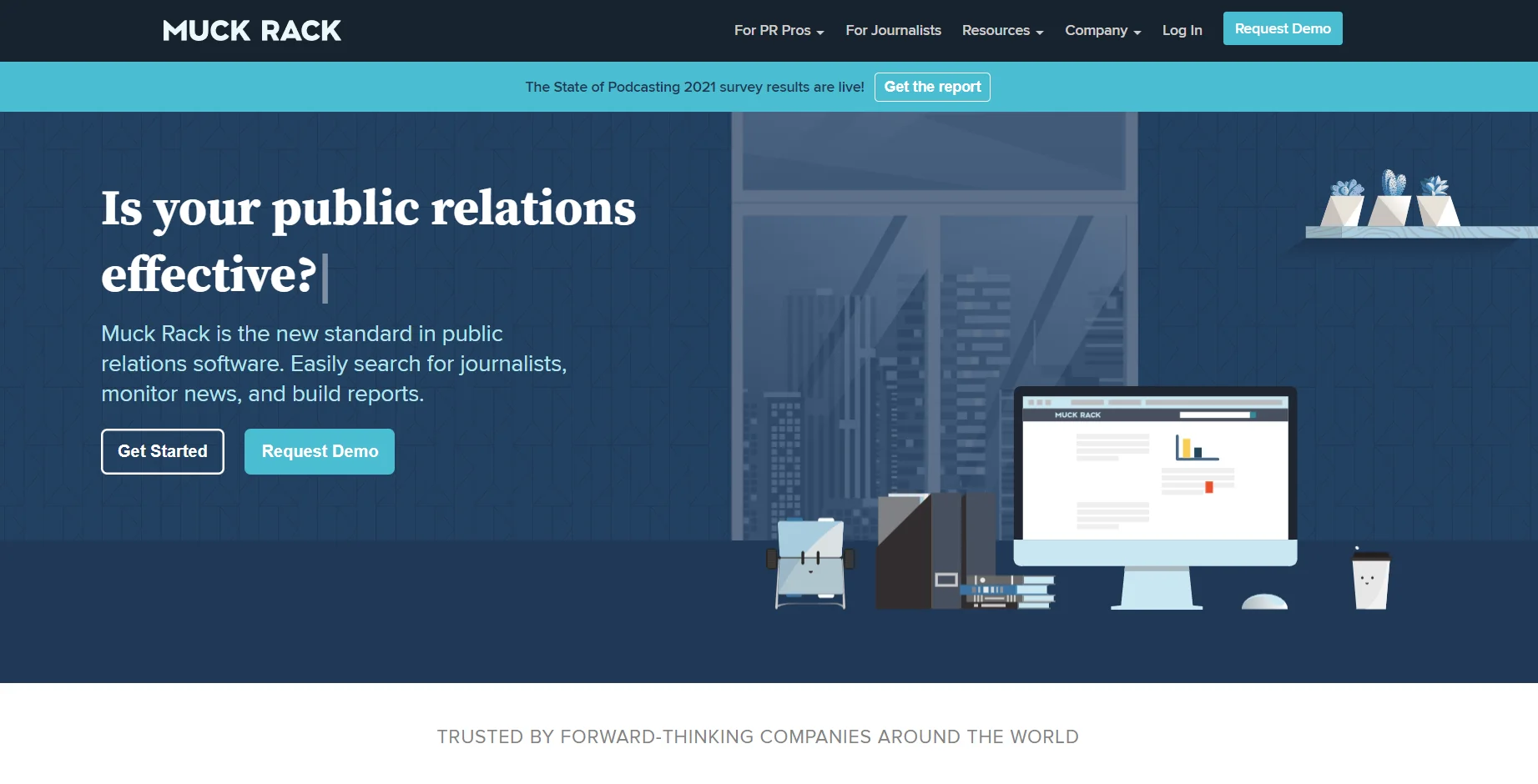
Muck Rack is a platform that enables the public relations team to come across pertinent journalists to build media relations for their organization. It is user-friendly software whose email system keeps one thoroughly updated on everything that matters.
It helps with Pr pitches for journalists, automatically analyzes press hits, identifies the latest trends, and lets you create newsletters/presentations. This all-in-one PR software act as a centralized PR platform, helping you research and make contacts within the industry.
A few prominent organizations that make use of Muck Rack include Taco Bell, Pfizer, Golin, International Committee of the Red Cross, Knight Foundation, Kauffman Foundation, and Penguin Random House and so many more. Muck Rack’s estimated price is $5000 per year, differing according to the features you choose.
B) Meltwater (A drone camera for media marketing):

Meltwater is the world’s first online media monitoring company. Meltwater has been used for over 20 years and hence can easily differentiate relevant content out of the ocean of information available online today. It brings over 500 million pieces of information every day and keeps adding new sources as well.
The tool performs news monitoring, and monitor print media, over 25,000 podcasts globally, TV and radio and social media. Not only does it provide media monitoring but also provides media database, social listening, social media engagement, and social influencer management. Each of which is described below.
Media database; helps PR teams find critical information required to build relationships with relevant influencers and land their next big public story. It helps with social listening hence making you aware of everything; where everyone is talking about your company.
The social media management tool offered by Meltwater helps streamline the process of engaging with the audience. It tracks competitors, scans conversations, and picks out the most relevant ones. All in all, Meltwater make tasks easier for you and takes care of your company at effective costs. Based on research, the software costs around $4000 per year, some sources cite $6000.
C) Burrelles:

Combining sophisticated technology with specialized expert analysis, Burrelles’ new technologies and expanded product portfolio provide a simple, seamless and personalized connection to media data across all of today’s channels. Its comprehensive suite includes media monitoring, communication tools, in-depth customized reporting, analytical research, press release distribution, media contact database, data services, and professional services. With unparalleled expertise and industry insights drawn from more than 130 years of relentless innovation and dedicated client service, Burrelles takes media data beyond automation.
D) Prezly:

Prezly is a Public relations tool for better and faster cation. Prezly speeds up comms workflow and contact management is made easy by this software. It tracks conversations; teams can leave private notes on the timeline as well. According to surveys; a large number of people rely on manual search, which can be very time-consuming in today’s time. So Prezly speeds up the process and makes everything well-organized by using filters, tags, relationships (add notes to contacts to keep a record), automation (use icons to highlight contacts needing attention), and enrichment (system finds out additional information from search engines and adds it up to the contact information automatically).
Prezly allows you to publish press releases and also lets you create content your way, delivers your content to the right people, keeps spam mails away, and creates well-structured emails. It costs around $50 per month varying according to the plan. Big companies like Ikea also make use of Prezly.
E) Mention:

Mention is a popular media monitoring tool that helps companies with decision-making. You can easily manage your social media accounts and perform other actions from its dashboard. A few prominent clients include Airbnb, Spotify, and Microsoft etc.
Mention monitors the online media, looks out for brand competitors, which helps plan further strategies in a smarter way. It manages your brand by responding to crises right in time, gets you the audience insights, which helps improve, pilots your social channels, and helps your agency grow. 750,000 companies use Mention daily.
Mention has several pricing plans that you can choose from to fit your needs. The average price is €166 monthly.
F) Coverage Book:
Coverage Book lets you build reports faster and more efficiently. It does the grunt work for you. Instead of spending hours opening links and copying data; just by collecting URLs of your mentions, the software gets your data in line for you. Also, it adds relevant images and makes a fancy report within minutes which is, all ready to share. It saves time and sanity. You can also review individual articles and evaluate the impact with the tool. Further, your created report can be edited according to requirements.
The pricing depends on which plan one chooses. The annual plans range between $1089-$5489.
G) Google Alerts:
Google Alerts, send emails to the user when new content related to the search engine pops up on the internet. It keeps one updated about the recent information that matches the search terms. It helps users schedule alerts. One of the most striking features of Google Alerts is; they come free of cost. One can monitor media without paying a penny. However, there is one drawback of Google alerts that it isn’t as well developed yet as the paid software’s are.
H) Cision:
Cision is a media monitoring company known for its avant-garde public relations software that offers marketing resources, public relations services, media contacts database, and press release distribution. Some prominent clients include Citrix, LinkedIn, and 3M etc.
It helps understand brand reputation with help of globally collected data, helps relationship management by increasing outreach. Its top traits include tracking distribution, analyzing features, and making sure you never fail to prove the value of your agency PR efforts. It understands your audience and offers analytics that is insightful and appealing.
The pricing depends upon the package you choose. It is estimated to be around $7200 annually.
I) Brand 21:
Brand 21 is another amazing tool that helps with brand building and integrated marketing expertise. A few users include- BMW, Starwood Hotels and Restaurants, American Express, Microsoft, L’Oreal, and many more.
The tool helps you develop strategies that make your business reach greater heights. It lets you conduct webinars and events to help you go about developing your organization better. With this digital PR tool, you can track your brand rapport, share alerts to your team, and work with one on one follow-ups.
Price starts from $49/month.
J) Anewstip:
Anewstip is a Public relations platform through which media influential and marketers can connect. It helps users find relevant contacts by news, tweets, and profiles. Besides this, it also monitors global articles, news etc. It organizes the media lists and contacts; helps reach journalists through private pr pitches. It also lets you filter out the journalists according to their language and topics.
The tool has various plans to choose from and comes with a 7-day free trial. The average cost of the software is between $200- $400 per month.
K) Agility PR Solutions:
Agility PR Solutions provide media monitoring and analysis software services. It provides a clear picture of your coverage, finds influencers, journalists who want to know your story, tracks your outreach, comes with a newswire tool, provides media intelligence services by doing analysis for you, making briefs, and so much more. It’s a user-friendly software designed to streamline your PR activities.
It doesn’t have a free trial and costs around $1000 per feature.
L) Brandwatch:
Brandwatch is a digital consumer intelligence company. Cision is its parent organization. It’s an AI analyst and gets you insights at a glance automatically. It performs an image analysis and segments data according to your needs. It can be customized and its UI can be combined to find useful insights. It is adaptable and bendable and comes with new technology, which has numerous positive aspects. The tool lets you track breaking news and is very useful during crisis situations and tracks ongoing PR campaigns.
A few prominent users include Nestlé, Unilever, Monster, Delta, Sky etc. It starts from $1,000 per month for 10,000 mentions.
M) Critical Mention:
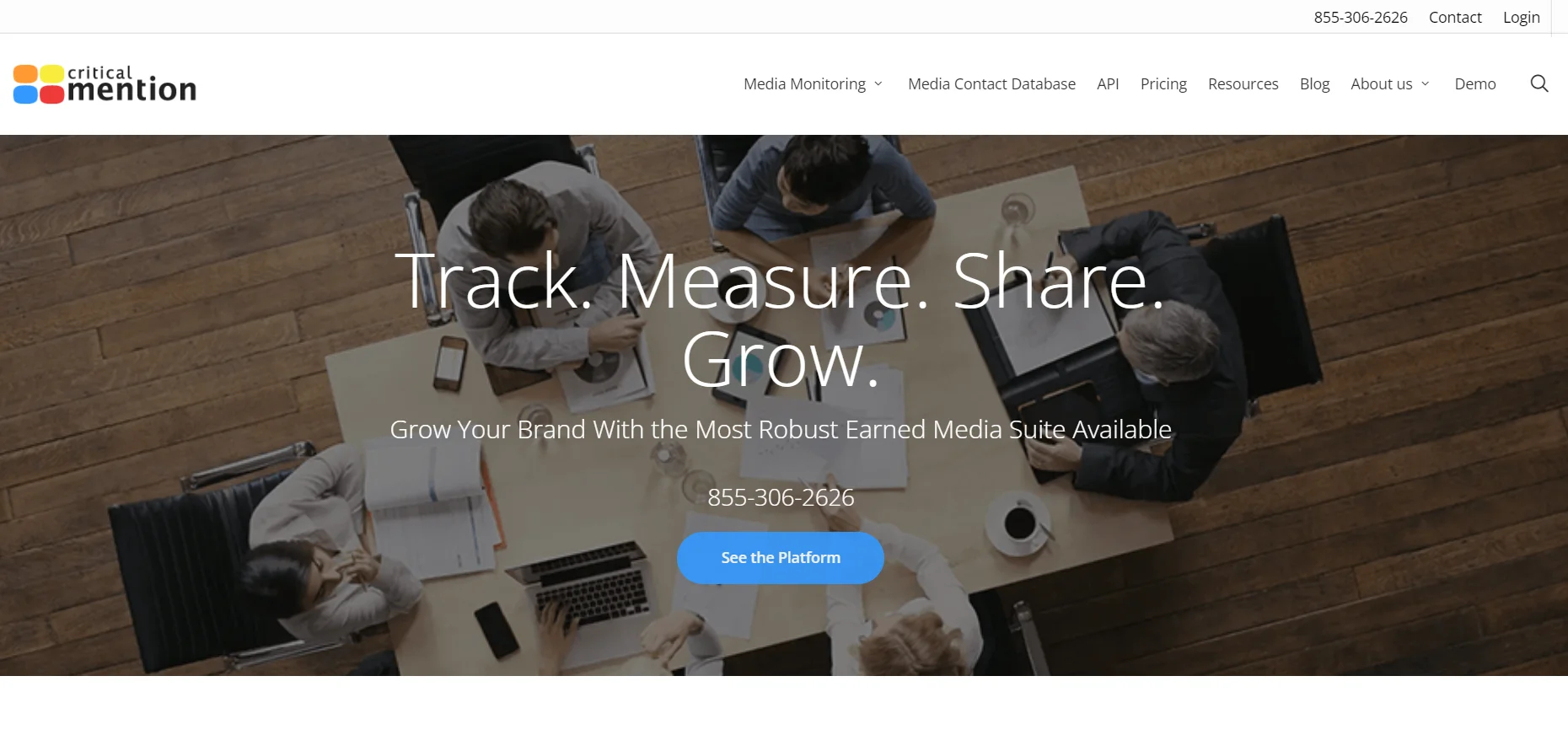
Critical Mention designs and develops software solutions. It is a reliable and fast media suite. One can get results within 60 seconds. The tool offers easy customization of your reports, improves analytics, and helps them share instantaneously.
Users can search global TV, social media & online news, watch videos, edit and share coverage, build reports, receive real-time email alerts, and analyze coverage using graphs and charts.
N) Journo Requests:
Journo Requests helps find journalist requests and instead of pitching to journalists, it involves responding to their requests. It filters out irrelevant requests and gives you instant alerts on requests in a specific category or based on specific keywords. The tool also provides free daily emails of all the useful mentions from your required journalist list. You can choose 25 categories for daily updates, and the price differs accordingly, starting from £600.
O) Help A Reporter Out:
Help A Reporter Out popularly called HARO is a platform for journalists to get public reviews. The tools help you connect your clients with journalists for expert sources. Journalists and bloggers provide their media outlets and information, submit a free source request, and HARO sends pitches to inbox directly. Using this tool helps you secure valuable media coverage. However, there are a few guidelines that the users must follow while using this tool.
HARO has a free version, but a premium version costs between $19- $149 per month.
P) Augure:
Augure is a CRM-style, cloud-based platform that helps track communications with journalists, offers social media monitoring, email marketing, and a range of other features and options for PR agencies and managers. It allows professionals to find influencers, engage with the audience, and measure the results.
With the help of this tool, relevant media content is compiled, which displays the success achieved on various media platforms. It helps improve ROI and brand management. The price is $350 per month for essential plans.
Q) PR Web:
PR Web works towards building brand awareness. Building text links to sites, adding keywords to URLs, submitting releases to search engines is all undertaken by PR Web. It ensures the digital footprint of your brand stays online and improves your brand awareness. PR Web provides tools to create compelling stories. It also provides a comprehensive report. All this makes it easier to influence target audiences.
PR web provides various options, affordable to expensive ranging between $99- $389.
R) Covered Press:
Covered Press is a Public Relations reporting system that provides analytics, real-time press alerts, and collaboration tools. It makes the job of publicists, journalists, and editors easy. Covered Press integrates with the graphic designing platform, Canva, which helps add visual graphics into reports easily. It offers white label reporting and streamlines three important tools- tracking, reporting, and analytics into one PR platform.
Covered Press pricing starts at $99 per month.
S) Business Wire:
When it comes to press release distribution and regulatory disclosure, Business Wire is a global leader. It is a trusted source for delivering news. It has been connecting audiences and organizations for about 60 years.
It provides tools for pr professionals, investor relations and distribution and analysis. You can reach more than 100,000 media outlets across 160 countries with Business Wire, assuring authenticity and credibility. Pricing is based on the word count of your press release, where 400-word PR starts at $325.
T) Radio Guest List:
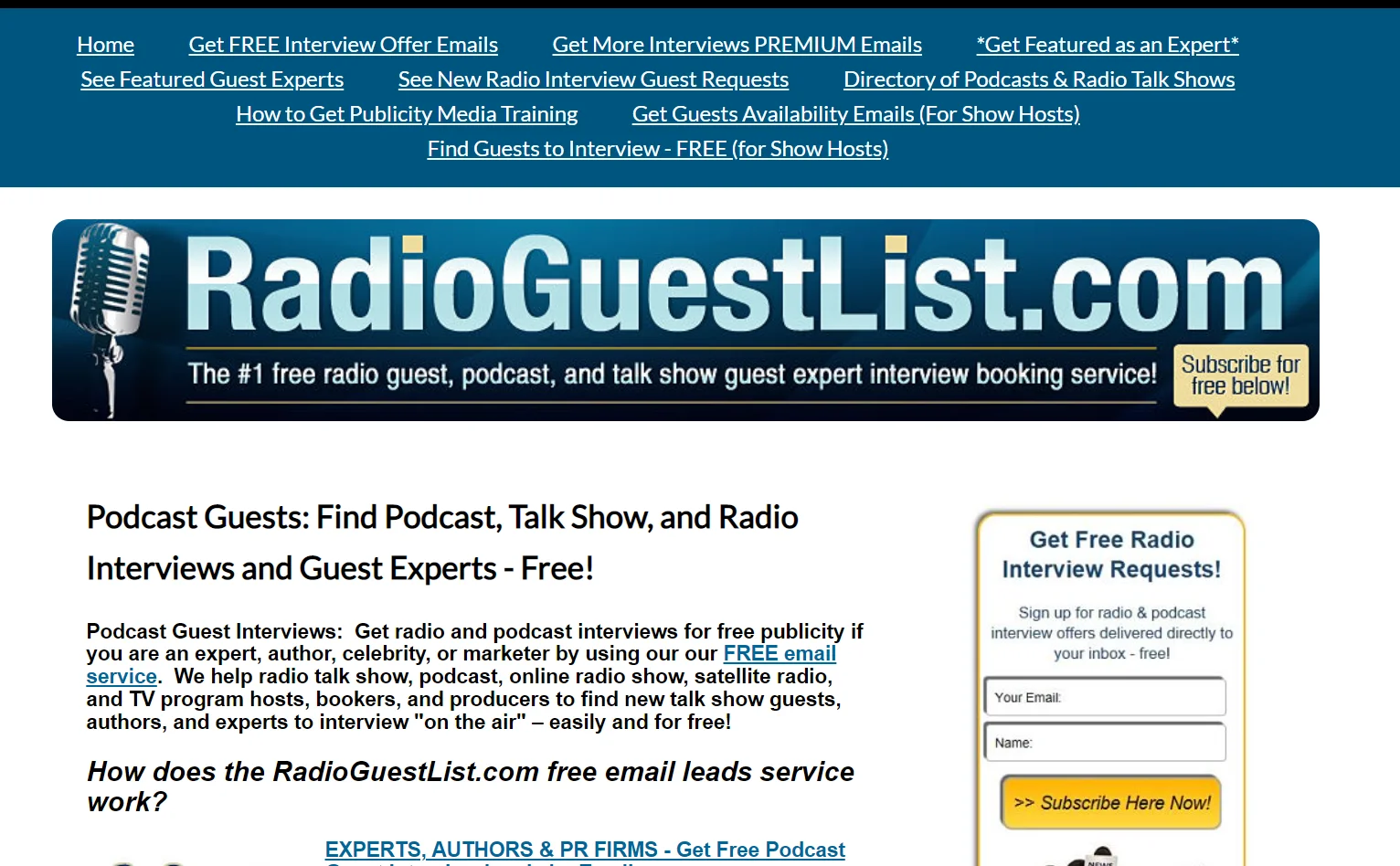
Radio guest list is a podcast guest booking service. It provides a platform for experts or brands to self-promote. They have talk shows every day. If a user signs up to their email, they send a guest request through mail, for free. Then the user can gain publicity through ‘on air’ interviews.
U) BlogDash:
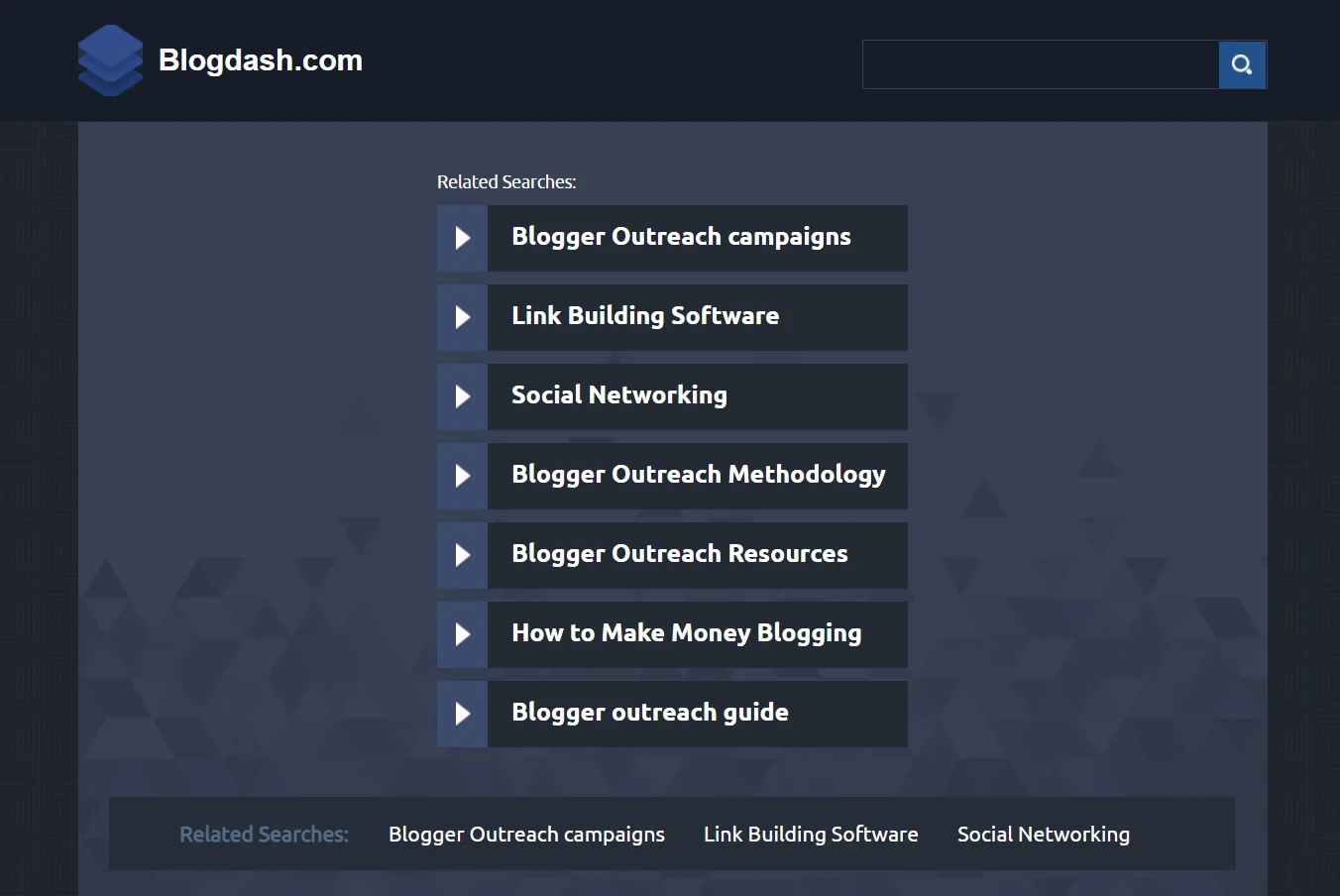
BlogDash is an outreach platform for businesses to connect with the relevant bloggers in various categories. It allows creating pitch lists, setting campaign goals, and tracking. They also have an outsourced service for managing content creation, blogger outreach, and tracking.
The price is $199 per month for unlimited services.
V) Pr.co:

Pr.co is a professional public relations firm that helps increase earned media coverage. It makes newsrooms for brands and PR agencies. It allows easy publishing of client news, manages complex editorial workflows, generates media exposure, builds press lists etc.
It considers diversity and inclusion and tries to mitigate environmental impact and contributes to communities. This is done through online magazines, events, and meetups. They offer free services to NGO’s and special programs for startups. The average costing is around £ 447 per month but varies according to add on’s to the basic plan.
Conclusion:
Being socially conscious doesn’t demand perfection, it involves sharing your story to inspire others to start their own. Today, media rules the world. Almost all our decisions are blinded by what the media presents to us. Google search has a significant impact on how your brand is viewed by customers, competitors, and the industry overall. So using public relations monitoring tools and public relations platforms can enhance the development of your organization and help you make it better. Not only does it improve the current status of your brand but also gives an insight into better decision-making in the future while nurturing your organization.
IPO or Initial Public Offering is generally the process of taking a company public. With an IPO, a private company offers its shares to public investors. But what is the actual process of going public? There are many questions that pop up in our minds when we talk about IPO. From what is the IPO process to how does an IPO works, every question creates confusion among beginners.
Generally, it is the process of going public for new investments for a private company. But there are many other processes included in the IPO timeline. Here we will talk about all these steps. Whether you are a beginner-level investor or you are looking for new investments for your private company, IPO is a must-to-know thing for you. You need to know all the IPO process steps. This post is a complete guide for the IPO process. From becoming familiar with the IPO process to filing for IPO, everything will be covered.
What Is An IPO?
The very first question that comes to mind is what is an IPO. Basically, we say that the IPO stands for Initial Public Offering. Before an IPO a company is private and not open for direct public investments. In other words, we can say that before an IPO, a company is not listed on any stock exchange. The only investors a private company has are angel investors, board members, family relations, etc. But with the IPO, the company became open for public investments.

The meaning of IPO is always the same for everyone, but the purpose can be different. As a private company, an IPO is an event when your company goes public. After that, your private company becomes public and will be listed on the stock exchange. Before it gets listed on any stock exchange, the initial shares are sold in an IPO. That is why it is known as Initial Public Offering (IPO). So basically, for companies, an IPO is the process and event to get public funding or investments.
For an investor, an IPO is an investment opportunity that gives him/her a chance to invest in the initial shares, securities, bonds of a private company that is just a few steps away from going public.
What Is An IPO Process?
The Initial Public Offering process is a long and confusing process, there are many steps involved. It is the preparation of going public before an IPO by a private company. There are much legal documentation, regulatory permissions, underwritings, etc. All these processes can confuse anyone. But here we will explain all the steps to help you know how do IPOs work.
The process is completely different when a private company is filing for IPO as compared to getting angel investments. To get angel investments, companies need to pitch the investors. But the case is different here with an IPO filing process. Here the private company has to find an investment bank as an underwriter. After that, different types of agreements and engagement letters are written for legal proceedings. Everything is explained clearly in the below-mentioned sections of this post.
Why Do Companies Decide To Go Through The Process of IPO?
There are several reasons behind going public. But the major and most common reason is getting new investments and raising funds. This is one of the most common reasons why companies decide to go through the process of IPO. Along with raising funds, there are many more reasons that push a company owner towards taking a company public. Before you know how to go public with the exact process of going public, you need to know the actual reason. Following are some of the common reasons why companies go public with investment IPO.
● Raising Funds:
As we have mentioned, one of the most common reasons behind going public is to raise funds for the company. All the private companies run with the help of the owner or co-founder’s savings. After that, these companies earn good capital with profits. That is all that they have, and sometimes they do have angel investors. But to raise a huge amount of funds, an Initial public offering is the best option. Here you will get investments in your company from retail investors.
● Company Image:
Company image or reputation is very important for success. No matter if you want to attract customers or new investors for your company, the reputation, brand value and authenticity you have, is always one of the important factors. So when you go public from a private company, your company gets a brand reputation built among customers and investors too.
● Safe Funding:
There are many other ways to get funding for your company. The companies can directly approach new angel investors. Also, there are chances that big enterprises will invest in private companies. Bank loans are also a good option. But when it comes to safe funding, the IPO or public listing is always the best option. There are no risks involved and no high debt interests are there to pay for a company.
● More Control:
Are you losing control over the management decisions of your company due to many angel investors? Then public funding can save you from this. Before you know what is the IPO process, you need to know what is the major benefit of an IPO. The major benefit is that you never lose control, even if you are getting a huge amount of funding through crowdfunding. Because there will be small and retail investors that will add a huge amount to your company capital through their small investments. So there will be more investments and fewer decision-makers.
● Transparency:
Transparency is always important when running a business. You must have to be transparent in front of the regulatory authorities, investors, public and customers. Does your private company have a transparent system in terms of funding, investments, revenue and capital? Being a public company, there will be more transparency, which will positively impact the overall reputation of the company.
● Financial Stability:
Financial stability is what all companies are looking for. No matter how much revenue a company is generating through its channels, if there is no financial stability, there will be no more growth. To win the confidence and trust of the investors and customers, your company needs to be a financially stable organization. Crowdfunding or stock exchange listing gives financial stability to your company. That is why an investment IPO is an important thing to consider.
● Liquidity:
Liquidity is also the major factor that you need to consider while filing for an IPO. It is important to know how to make your company public, but also it is important to know how initial public offering stocks can help you get the liquidity in your funds. Getting capital gained from crowdfunding will allow you to utilize the funds in any way to grow the company.
How Long Does It Take To Complete The IPO Process?
IPO process steps can take time to complete. But the question is how much time does it take to complete the whole process? The time taken is never the same for all the companies. It depends upon the size of the company and the way they choose to go public. There are different options available in the different stages of IPO. So all these options will decide the exact time that will be taken to complete the IPO process.
Usually, the minimum time that will be required will be six months. There will be a minimum of six months time that will take to complete the IPO process. But when it comes to maximum time then it can be from 9 months to a year. So on average from six months to a year is required to complete the whole process of going public. IPO timeline contains many complex steps so that it takes almost a year to go public and get successfully listed on the stock exchange.
What Do Companies Do Before An IPO?
Beginners may ask how does a company go public. There are many other questions asked related to IPO documents and IPO investments. To start the IPO procedure companies have to fulfil all the IPO requirements. After completing all the requirements, the process to file for an IPO will start.
There are basically many tasks performed by a company while it is preparing to go live. Before we talk about all the procedures and steps involved, we will talk about some of the major changes that a company makes in-house. There are many things that change when a company decides to go live.
Firstly, the senior management and executive-level officers get replaced and new hirings are carried. The management has completely changed. Sometimes a few companies also change the policies of the company. These are the policies that directly or indirectly impact the investors, public funding, revenue model and company reputation. However, these steps are not necessary to perform for any company. But still, almost every company changes a few things in their organizational structure, policies, etc.
What Are the Specific Steps that A Company Takes in The IPO Process?
Now let’s get to the point, what is the IPO process? There are many steps involved that can confuse anyone who is not familiar with the complete process of going public. That is why we have clearly mentioned all the IPO process steps. These steps are performed by all the companies that want to go public necessarily. There are no ways to skip these steps as they are related to legal documentation, policies, etc.
Step 1: Select an Investment Bank/underwriters:
Underwriting services are required while a company is filing for an IPO. Underwriters are also known as investment banks. A company that wants to go public, needs to find an investment bank for it. That investment bank will help the company in the underwriting process. There are many aspects that a company considers while choosing an investment bank as underwriters for the IPO process.
Step 2: IPO Due Diligence and regulatory filings:
The investment bank chosen by the issuing company is like a middle man between the IPO investors and the company. The investment bank will take care of all the underwriting on the behalf of the issuing company. There will be many things involved and the nature or mode of investment is chosen according to different agreements. These agreements will decide how an investment bank will work along with the company. It will decide whether the bank will be a broker or just an underwriter. Following are some important regulator filings and due diligence.

● Firm Commitment:
This is the first type of agreement or arrangement between the investment bank and the issuing company. In this type of agreement, the investment bank acts as a responsible authority providing the guarantee of a particular amount of funds to be raised. The investment bank will buy the initial public offering stocks from the company and will sell them to the investors and assure the company that it will raise a particular amount of funds for the company.
● Best Efforts Agreement:
Here in this type of agreement the investment bank just acts as an underwriter and does not guarantee any particular amount for fundraising. The company is solely responsible for the funds raised according to this agreement. Here the company just acts like a broker and sells the shares to the IPO investors on the behalf of the issuing company.
● Syndicate of Underwriters:
Sometimes investment banks are not sure about the safety of an IPO. In such cases, a bank never wants to take the whole responsibility and the risk of an IPO. So there will be multiple banks involved in an IPO with the help of a syndicate of underwriters. However, there will be a lead investment bank in this process of going public. And a strategic agreement is made between all the banks and they sell allocated securities, bonds and stocks to the investors.
● Engagement Letter:
An engagement letter is also an important letter in the list of IPO documents. The engagement letter clearly mentions the gross spread and the reimbursement cost terms between the investment bank and the issuing company. The engagement letter ensures that all the costs borne by the investment bank will be reimbursed. Also, it decides the gross spread, which is the margin between the buying price and the selling price of a stock for the bank.
● Letter of Intent:
A letter of intent is basically an agreement that makes it possible for both parties (issuing company and investment bank or underwriter) to commit to supporting each other. The bank commits that it will enter the underwriting process of the IPO of the company. From the company’s side, the commitment is to provide all the required information to the underwriter. The over-allotment option is also described in the letter of intent of an IPO.
● Red Herring Document:
The Red Herring document can be described as a marketing prospectus that clearly mentions the status of the company and the offering share price for the investors or buyers. This prospectus is used as marketing material in roadshows.
● Underwriting Agreement:
After the letter of intent, it comes to the situation where the offering price is decided in the legal proceedings or documentations. The underwriting agreement helps here. The underwriting agreement will decide and bind the underwriter to buy the shares at the described offer price.
● Registration Statement:
The registration statement is a kind of document that helps the investors to decide whether the issuing company is financially stable or not. Also, the behavior and status of the management are also described in this statement. The financial statements, status, progress and forecasting is involved here. The registration statement is divided into two parts, the first one is the prospectus that is for the investors and the private filings have the information that is provided to the SEC or any other regulatory authority.
Step 3: The IPO Roadshow:
The IPO roadshow is similar to any other general roadshow. But here the issuing company and the investment bank or underwriter shows their financial status, offer price and all the things important to know for a new investor. The roadshow is not basically a roadshow, but it is a collective meeting, seminars, webinars, conferences, etc. These events are known as the IPO roadshow. The presentations are given in front of the investors, retail buyers, institutions, etc. to attract them towards the upcoming IPO.
Step 4: IPO Pricing:
After getting the approval of the IPO from the regulatory authority such as the SEC, the company and the investment bank will decide upon the offer price of the share units. Also, the issuing company and the bank decide the number of units or shares to be sold in the upcoming date. All of these prices are decided on an effective date.
Step 5: Going Public:
After everything is decided and approved by the regulatory authorities, the IPO will go public on a specific date. The investors will buy the shares from the investment bank for the specified issuing company.
Step 6: IPO Stabilization:
The stabilization is carried after the shares are publicly sold in the market. The investment bank or the underwriter will purchase the shares to stabilize the whole market for the stock.
Step 7: Transition to Market Competition:
Now the final step is to transition the stock to the market competition from the IPO. This process starts almost 25 days after the completion of the process of going public.
When Does A Company Go Public?
In the USA the Securities And Exchange Commission has set the eligibility in two parts for the companies. The first one comes under the “Emerging Growth Companies”. A company can apply for IPO under this section if it has an annual gross revenue of less than $1.07 billion. The second eligibility criteria are “Smaller Reporting Companies”. A company comes under this criteria if it has a public float of less than $250 million or annual gross revenue of less than $100 million.
After getting eligible under the different clauses and sections decided by the SEC, the companies can go public anytime when they feel it is the right time to raise funds.
What Are The Pros And Cons Of Taking Your Business Public?
If we count on pros, then the list is way longer than the cons. But still, there are some significant cons of the Initial public offerings. Following are some of the common cons and pros of Initial public offerings.
Pros:
● Safety is an important thing and fundraising through IPO is the safest mode as compared to bank loans.
● The reputation of the company becomes more positive and stronger in the market.
● Crowdfunding can help you get more funds along with losing less control over your company.
● It brings transparency to your company’s revenue model, investments, capital and policies.
Cons:
● The cost of taking a company public is very high.
● There are many steps involved that can make a beginner confused while filing for an IPO.
● It usually takes a long time to get your IPO approved by the SEC.
What Parties Participate in the IPO Process?
Firstly, the issuing company is the major party in the IPO process. After that, the investment bank or underwriter is involved. The regulatory authorities such as SEC in the USA and SEBI in India, are involved. Along with this if we talk about the investors then there are both kinds of investors involved in the IPO process. Institutional investors are also interested in IPOs as well as the retail investors putting their money in such investment opportunities.
Metrics for Judging a Successful IPO process:
Several factors or metrics are used and analyzed by the investors to evaluate the success rate of the IPO process of a company going public. The major two factors are mentioned below.
Market Capitalization:
Firstly, market capitalization is important to consider. It usually takes a month after the IPO when you can easily evaluate the company value with the help of market capitalization. You just need to keep an eye on the market capitalization of the issuing company along with its competitors in the market. Market capitalization will help you know whether a company is conducting a successful IPO for the investors or not.

Market Pricing:
Here again, market capitalization is the important metric to consider. The difference between the initial offer price and market price after 30 days of IPO is very significant. If it is less than 20%, then the IPO can be considered a good and successful investment opportunity. Otherwise, if it is more than 20% then it is not considered a successful IPO.
Conclusion:
IPO or Initial Public Offering helps the private companies go public and get more fundings with the help of crowdfunding. Before being a public company, the private companies had angel investors, personal funding, bank loans, and many other sources of funding. But the safest mode of getting funds in a big amount is to get your private company to go public.
Being public means that your company will be listed on the stock exchange. To do that the company has to know how to file an IPO. After that, the company will file the IPO with the help of an investment bank or underwriters. After that, all the IPO steps are performed and then the company gets approval from the SEC. Before the IPO, the IPO roadshows are conducted to attract new investors. After that, the retail investors and the institutional investors take part in the IPO and buy stocks of that company at the offer price.
Press releases have been a part of journalism for over a century now. The first press release being published back in 1906, when Ivy Lee, the then public relations expert for the Pennsylvania railroad broke the news of a tragic train wreck that took the lives of over 50 people.
Instead of waiting for the reporters to cover the story, he took it upon himself to write an honest review of the incident and sent it across various news agencies. The NewYork Times was quick to respond to it. Not only did they publish the story but published it in exactly his own words, just the way they received it. And hence, the first press release was born!
What is a Press Release?
A Press release (PR) is a piece of information that you can send across various media channels, publication houses, and newswires for distribution. You can also send them via e-mails, post them on your website, and social media platforms for an even wider media coverage.
Unlike information received from other sources, a press release is verified by default as it comes straight from the point of origin itself. What’s more is that it contains a first hand account of the actual event, which if found newsworthy is reprinted in verbatim in most of the cases.

Although, any information that you send deliberately to press or media is considered a press release, majority of public relations professionals follow a standard format when submitting it. Thus, a good press release would answer all of the 5 Ws of journalism i.e. Who, What, Where, When, and Why, regardless of whether you call it a press release, news release, or a press statement.
And that also explains why more than half of world’s journalists tend to prefer press releases over other ways of news gathering. Aside from making a journalist’s job easy, a press release is also a legit way of reaching out to public or your audience. Its motto being accuracy, authenticity, and public interest. Now, you may think that the rise of social media might have made pr press releases obsolete. But that’s not the case!
Why Press Releases are more important than ever?
Gone are those days when PR could only be used for making official statements and public announcements. These days you can use it for a number of other reasons such as branding, marketing, promotion, ceremonies, events, research publication, and anything of value that you want to spread the word about. And then there is “fake news!” Which has occupied such a large space of online community that it’s hard to make a difference between facts and fiction.
Press releases, being the original piece of information can make a lot of difference here. When done right, it would most certainly get you the media coverage, plus the audience you’re looking for. And should your story be engaging enough, it would find you the right audience faster than you can imagine. Not only would it draw a larger audience base at once, but would also drive organic traffic, more shares, as well as arouse a broader interest for your brand in both the media and the public. And that brings us to the importance of press releases in public relations. Let’s take a look:
- PR can be used for announcing a new product or service, as well as upcoming sales and promotional offers. By including all the product details such as specifications, pricing, stock availability, updates and so on, you can offer more value to customers without having them to look for it.
- Improving brand image is another astounding effect of a good press release. That’s because press releases can provide a relevant, accurate, and valuable account of your business to your targeted clients and interested profiles.
- Press releases and newsletters with eye-catching visuals and images help drive interest. High-quality images can do a lot more than draw attention. They can tell a whole story! In fact, a media press release with an appealing image is 7 times more likely to be read as compared to the one without an image.
- The primary purpose of press release is instant world-wide distribution. Compared to its early days when press releases were limited to papers and newswires, modern tech has brought various other means of distribution such as e-mails and social media for swift and easy transmission.
- Press releases are quite useful when it comes to expanding public knowledge. It’s a great way of communicating with your audience directly, and deliver messages in an interesting, informative, and entertaining manner.
- Viral possibilities- Press releases can easily go viral should they be valuable enough. They are a permanent piece of record on your company’s website, which can easily be accessed via any internet enabled device round the clock.
- Portability and convenience are yet another qualities of a press release in the age of information. A smartly crafted press release would be easy to understand without having to go through the entire content. And that’s something you can do using special characters and elements such as bold letters, catchy quotes, and underlining etc. The point is to make it look more appealing, scannable, readable, and comprehensible at a single glance.
- Search engine optimization is the key if you want to come up at the top of the search engine rankings. By including targeted keywords and links in your press release, you can make it more friendly to google search criteria.
Now as important as press releases have become in the modern digital age, the fundamental rules of writing a good press release haven’t changed much.
What do you need to know before you start writing a Press Release?
Press releases can be used in a number of situations. What you need to know is whether or not a particular situation needs a press release article. Remember the thumb rule for creating a press release is that it should be of public interest. So as long as you’re able to draw the public’s attention with it, you are okay! Once you’re sure that it would be of some use for the public, you can get to the actual reason for publishing a press release in newspaper.
Here’s what you need to understand before writing one:
– What do you want to accomplish?
– Is it for branding and marketing?
– Or do you want to add more subscribers with it?
– Or maybe you want to promote a product or service? And so on. (I hope you get the idea!)
Another thing to keep in mind, is basic journalism which as I already mentioned revolves around the 5 Ws. Now, depending upon the actual reason of publishing a press release, you can choose from different types of it.
What are the different types of Press Releases?
Press releases can be published based on your long-term goals as well as short-term objectives. Keeping that in mind you can design the content of a press release while sticking to the standard format. And yes, don’t forget the 5Ws!
Okay, so here are the different types of press releases:
1. New/Improved Product Launch:
It is a type of press release that can be used to offer valuable insights about new products and services. That includes product’s specifications, pricing, availability, improvement, date of launch, and other details that you might think of value.
2. Upcoming Events:
Upcoming events can also be promoted using press releases and newsletters. This type of PR press release would contain everything about the event starting from its objective, venue, pricing (if any), invitees, and other important details.
3. Grand Opening:
Grand opening press releases can be published in many scenarios. For instance when you’ve opened up a new office or business, or relocated, or even if you’re trying to kick-off a start-up. This type of press release must contain the date, timing, and the venue of the grand opening, important participants, schedule, and any other noteworthy aspect of the party.
4. Executive promotions/ New hiring
Executive promotions/ new hiring are always crucial for a company and its success. A press release here can be used as a compelling way of establishing the credibility of your frontline workers on behalf of your business.
5. New Partnership:
New Partnership with other businesses is mostly a win-win. Plus letting the public know about them would only make your business practices more transparent and customer friendly. A press release is a great way of doing so with intrigue. But to do that correctly, you must include the reason why you’re partnering up in the first place, followed by a brief summary on each company, and most of all how does it help your customers, clients, and stakeholders.
6. Awards:
Awards are for winners. And winners love to celebrate! Besides, releasing a statement about your accomplishments as a business can help you establish your brand’s authority in the market. It can also help you earn the confidence of your sales prospects in your products and services.
7. Crisis management:
Crisis management or crisis communication press release is all about being transparent with your audience. Especially when your business is hit by some sort of crisis, be it financial, organisational, technological, natural, or internal. This type of press release should highlight the problems your company is facing, the impact it has made, and the plan and course of action that you’ve taken so as to minimise its effects.
8. Mergers and Acquisition:
Mergers and Acquisition are worth releasing a press statement. That’s because merging with, or acquiring a new business or a company is a sign of growth that would impact your entire business and the people around it. Make sure to include all the details such as the companies involved, their area of expertise, and any message of value their thought-leaders want to convey.
As you can see, press releases can be circulated for a number of reasons. All you need to do is stick to the rules, specify the information based on the type of release you want to publish, and I’m sure you’d be able to write a good old-fashioned press release in no time!
Speaking of which, let’s find out how to write one.
6 Essential Parts for writing a good Press Release
Press releases have come a long way. Yet, haven’t changed much. Although the means of communication have evolved, the basic idea and structure of a press release remains the same as it was before internet. That is, 4-5 paragraphs of total word limit between 400-500, and the over-all length of press or news release being anywhere between 300-800.
The essential components of a good press release are as follows:
1. Headline/ Title:
The first thing anyone would notice in a press release, or any news article for that matter, is its headline. The catchy it is, the more likely it is to grab your attention. It’s what will attract the reader to the whole story. And for that you would need to make it spot-on, something that you can do easily by making it relevant.
You can also include the targeted keyword in the title but make sure that it doesn’t sound like a sales pitch. In fact, that’s the last thing you want to do with your press release. The characters should be somewhere around 60 for Google, while the word limit could be anywhere between one to six. Also make sure to use upper case in all the words of a headline except for the words with 3 characters or less. Remember, the goal of a headline is to arouse interest. So keep it short, sweet, and informative.
2. Dateline and lead paragraph:
Okay, so you have your reader’s attention. What now? Well, now is the time to answer the 5 Ws!
Start by mentioning the date and the place of the origin of the story, followed by a simple and short account of upto 25 words so as to keep the reader engaged into what you have to say. You should also refrain from using fancy words and phrases in the lead paragraph. Instead, keep it to the point and include only the key information that you want to announce to the public.
3. Contact Information
Contact details of your communication officer is also something that you can mention at the top should a journalist wants to get in touch. It should include the name of the public relations representative, company’s name, telephone number, website and email address. By having a separate spot for contact info, you can save a lot of space in the body section and use it to convey the story at hand.
Here’s a perfect example of a product launch press release wherein as you can see the contact info is mentioned right at the top, next to the title.

4. Body Section
This is the main part of a press release where you can cover the whole story with all the relevant details such as facts, stats, images, videos, charts, hyperlinks and anything else of value. Body section also allows you to cover the 5Ws incase you weren’t able to do that in the lead paragraph for some reason. You should do this in the first paragraph of the body.
In the second paragraph, you can use quotes and insights from those involved or effected by the release to support your story.
The third and the last paragraph of the main body would be all about summarising the news and key points made in headline and above paragraphs.
5. Boilerplate Statement (About the company)
Boilerplate statement is a general description of your company and area of expertise that you can use over and over again in business press releases so as to tell the people about your business and what you have to offer. You can also add links to your website and social media pages to direct the readers to your content in this section. A common way to do so is to include an “About the company” section right at the bottom.
Here’s a superb example of a boilerplate statement in a press release:
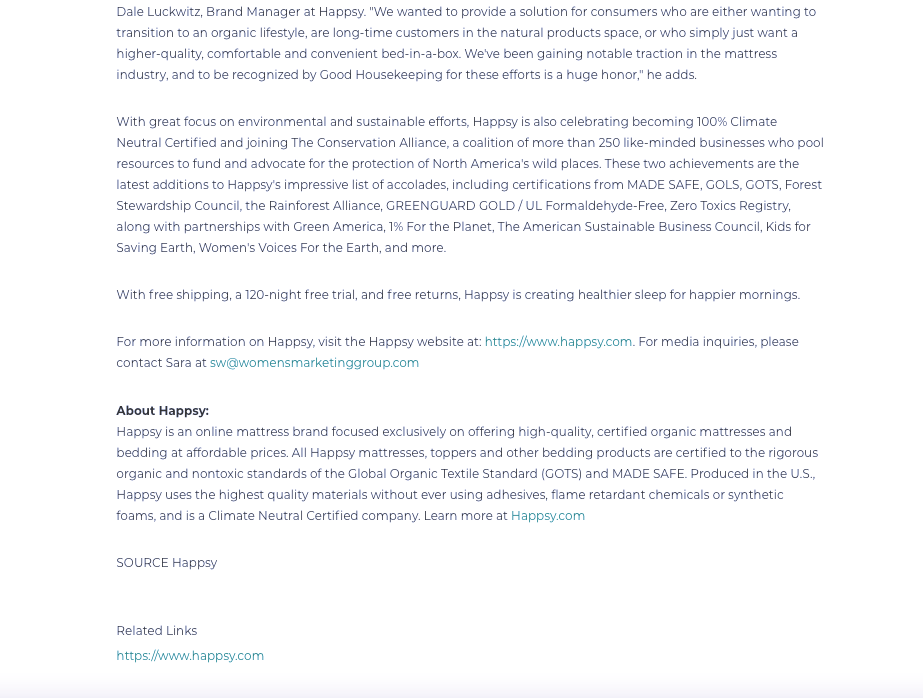
6. Call to Action (CTA)
Although, a press release information should not sound like a sales pitch, in no way does it mean that you cannot use CTAs in it. In fact, one of the main purposes of an online press release statements is to drive web traffic to your website. But to do that correctly, you must first realise the goal of your press release. So if it’s intended to target web traffic, you can use the “learn more” tactic as a CTA. In a product launch press release, you can use “limited period offer”, or “pre-order” button and so on.
It could also be a simple invite of sign-up, weekly tips, or an invitation to become a part of an event or member of the company’s community. The point is to include an appropriate CTA at the end of every press release so as to create opportunities while getting all the public attention you desire.
Example of a good Press Release:
Although, thousands of press releases are being published everyday, only a few make a lasting impression. Below is a cool example of press release made by early childhood nutrition company “Gerber”! It’s an event and award announcing press release that contains almost all the elements of a good press release.
Here, take a look:
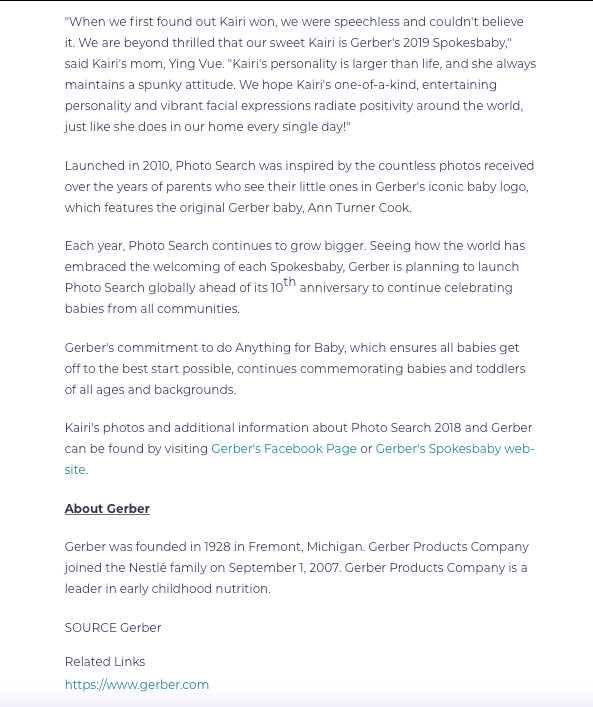
Tips for publishing Press Releases:
Writing a press release is only the first part. The next challenge is to get it published by news media for which you’ll have to send it across multiple news channels including newswires, social media, your website and blogs, and other places that you believe can get you the media coverage you want.
Here are some of the tips that you can use to get the best out of a press release:
1. Reach out to specific journalists:
Bombarding the press with your press release is not a good idea. You must do it in a professional way by contacting only those journalists and reporters you know well, preferable those who’ve worked with you or your company in the past.
2. Don’t be afraid to go offline:
Press reporters usually have a lot on their plate to deal with on daily basis. And thus it may not always be easy for them to sort through each and every e-mail, unless of course they have prior information about a particular one.
Regardless, you should stay on a safer side by including offline mediums of reaching out to media as well. You can use ordinary post or any there offline channel you find feasible.
3. Send the release to top journalists the day before:
Best journalists take time to get familiar with a news report to be able to craft a story around it. By sending them the release prior to the day of publication, you can give them ample of time to prepare. You can do that by sending the press release in embargo, which means that although they can go through the release, they can’t share it with public until the time that you have specified.
4. To avoid competition, don’t publish your release on the hour:
Timing is also crucial when it comes to publishing a press release, especially with online newswire services. Instead of posting it at the exact hour, when most companies want their releases to go out, the smart thing would be to either submit it before the hour or after the hour.
For instance, instead of publishing it at 0100 hrs, or 0300 hours, you should try 1:15, 2: 30, or 3:20, or any other random time of the hour but never on the exact hour.
5. Share your media coverage:
Once your press release is published by the press, comes the time to share the media coverage you’ve got. Sharing your success stories and what media says about you is a great way of promoting your release.
Conclusion:
A good press release, complete in all its requisite elements and structure can generate a lot of public attention and awareness about your brand and values. If done right, it can drive significant web traffic to your website, boost leads, and increase the over-all ROI without increasing your expenses.
But remember, a press release usually has a short-term impact as it lasts for a couple of months at max. So try and come up with useful press releases whenever it’s possible especially when it’s about public interest.
How to Save Money Consistently
When it comes to saving, CONSISTENCY is crucial! To maintain solid progress in your saving journey, consistency would be vital.
Here are a few consistent saving tips.



About GEM COMM
We are an International Investor Relations firm (IR) based in Singapore. We specialise in Investor Relations, Public Relations, marketing, branding and messaging strategies for clients that include organisations of all sizes across Asia, Oceania and US.
GEM COMM advice and solves stakeholders’ issues, drive growth, reposition your business, improve your marketing and Public Relations (PR) or engage with investment community in your leadership or strategy story. We have a track record of helping clients reach these goals. We create and implement PR & media content, mitigate crisis and issues, establish and improve thought leadership & content marketing.
GEM COMM Engagement types include:
- IR/PR retainer program
- Crisis and issues projects;
- Content marketing (from research to lead generation) inclusive of Press Release drafting, Media Pitch, Website content, etc.
Choosing between an external PR agency and in-house marketing is always a tough call! After all, Public relations is an essential aspect of marketing without which your company will not succeed, let alone grow in a profitable manner. In fact, PR is believed to be about 90% more successful in influencing consumers than other means of marketing such as advertising. As you can see, the scope of public relations is well documented with its market value expected to reach over $90 billion by 2022. Yet, as important as it is, choosing the right kind of PR campaign could be equally challenging. Especially in this age of information where media relations are getting harder to maintain than ever before. Aside from that, partisan politics and advancements in technology are making public relations even more challenging. No wonder why most business owners find it to be extremely confusing when it comes to choosing between an external PR agency or in-house marketing. Either way, the primary goal of a public relations strategy remains “publicity of your brand!” i.e. creating, maintaining, and improving your brand’s public image for scalable growth in your business. Although many businesses are transitioning to in-house marketing as of late, that does not mean that you have to do the same. Remember, the key to choosing the right PR agency depends solely on your business goals and your own limitations. Before we get into that, let’s quickly find out what PR is.
What is public relations (PR)?
Public relations is the process of creating a positive image of a person, brand, or service. In business, it’s usually done by using various means of marketing and branding such as press, digital media, social networks, automation, and analysis.  Unlike marketing, which is mostly to do with promoting your products and services, public relations is a vast domain that impacts many areas of a business. Along with creating a positive image of your brand, it also increases brand visibility, brand awareness, and boosts the over-all search engine rankings of your website which is quite crucial for if you want to run a successful business in today’s digital market. So with that in mind, I’ve put forth an explicable account of both agency marketing and in-house marketing along with their pros and cons which will hopefully help you get to a final decision without wasting any more time. But first let’s quickly understand the major difference between the two.
Unlike marketing, which is mostly to do with promoting your products and services, public relations is a vast domain that impacts many areas of a business. Along with creating a positive image of your brand, it also increases brand visibility, brand awareness, and boosts the over-all search engine rankings of your website which is quite crucial for if you want to run a successful business in today’s digital market. So with that in mind, I’ve put forth an explicable account of both agency marketing and in-house marketing along with their pros and cons which will hopefully help you get to a final decision without wasting any more time. But first let’s quickly understand the major difference between the two.
Difference between PR agency and in-house PR team
PR agency is an external marketing firm which you can hire to promote your brand and market your business. An in-house marketing team refers to a dedicated team of PR professionals from within your company who are responsible for handling public relations and media affairs. Now let’s go through the pros and cons of each without any further ado.
Why should you hire a PR firm?
A PR agency is a suitable marketing solution for if your brand is new and eager to build a larger audience base. It’s also a quick way to build your brand’s credibility in the market should you choose to scale your business. Let’s take a closer look at the various benefits of hiring a PR firm:
- PR Agency has pre-built media relationships: Media relations are getting harder as we speak. About 3/4th of PR professionals admit to seeing a 25% rise in the challenges associated with building new media relations. This could get even more challenging if you’re new in the market. That’s because building new connections can take months and years of effort. A PR firm in this context can help you a great deal due to the network of long line of media relations that they might already have built. A good PR agency could cover a variety of marketing channels to get you the publicity you need in quite a short span of time.
- They’ve got the experience you need: Let’s say you’ve built your business from ground up but have no idea how to manage your public relations. Employing a full-time in-house team, in this case, won’t do you any good either unless you as the owner have prior knowledge of the field. And that’s where an agency, which has worked in the industry for years and have gained substantial experience comes into picture. The agency would be well-versed with all there is to know about public relations. Not only would it reduce your workload but also bring in a lot of insight into how public relations is managed in real-time in modern digital market. Plus, you’ll also get their experience!
- You gain a new perspective on your company, brand, and customers: Imagine paying someone to give you the most honest feedback about your brand and business practices! Sounds awful? Well, it shouldn’t! Getting a fresh opinion on your business, products, and customers is never a bad idea. Even if you have to spend a little. While your in-house team may not be very critical of your work ethics and business values, an external agency would be more than open in telling you where you lack. Most PR agencies look for new ways to boost your publicity and will leave no stones unturned even if it means changing the entire make-over of your company.
- Agencies have a greater understanding of trends, the media landscape, and the big picture: Being in the industry for long, the agency would have seen many ups and down in the market. As a result, they’ll be well prepared with all the knowledge of what’s working in the market and what’s not. Besides, acquiring deep understanding of the local market, trends, tactics, and the habits of the target audience, is what PR agencies do. It’s basically what PR agents eat for breakfast!! And then they go to PR events across various industries and sectors so as to have a broader sense of the current landscape of the media and the future it holds. A clear understanding of the big picture that PR agencies have could help you a great deal in building your public image the way you desire.
- PR Agency has countless workers under them to do your bidding: A PR agency is a separate firm with its own pool of talented workers who’d be more than dedicated to improving your public relations. What’s more is that these skilled individuals would be able to cover a wide range of marketing channels and outside resources in a very short time. They’d be well versed with latest tools and technologies to cover all your marketing needs and which brings to our last and the most important advantage with hiring a PR agency.
- PR Agency comes with its own list of tools required for success: Modern businesses tend to use every technological advancement that they can for a variety of purposes. Be it automation, analysis, collaboration, or data transfer. PR agencies haven’t stayed behind in this race either. Most PR professionals use a number of marketing solutions including automation tools, web analytics, marketing cloud, email automation, and CRM software for marketing and branding. A PR agency would apply various tools and technologies depending on your goals and requirements.
Why should you handle your public relations in-house?
While a PR agency would offer many advantages to a start-up or a small-scale business, an in-house team would be perfect for well-established brands that have been in the industry for a long. Let’s take a thorough look:
- You know your business better: Unlike a PR agency, which may or may not understand your business values, an in-house team would have a fair idea of your goals and vision. And so in a way, they’d be more committed towards your goal than an external agency. While an external PR agency could definitely help you come out of an emergency setback, your in-house team would be more than capable of building your brand’s authority in a long run. It would also allow you to manage the team and projects from up close, and help you monitor the quality right from the start to finish. Plus, you’ll also get first hand-experience of the market.
- Less expensive than a public relations firm: Although a PR agency would cost you somewhat less, in no way would it be a long-term investment. Remember, a PR agency is fine if you want to be build some credibility in the market in a short term, but if you’re looking to build a solid image for years to come, then having a dedicated in-house team would be your safest bet. And given the right tools and training, I’m sure a dedicated lot would be able to meet all your marketing needs without having to ask for a PR agency! No wonder why more PR work is taken in-house than being outsourced to external PR agencies.
- You’re the top priority: Since a PR agency handles several clients at a time, it may not always be possible for them to give you priority. Although most agencies are flexible with communication hours and payment, you can’t always be too sure. Having an in-house team, on the other hand, does not pose any such challenges. It’s reliable, easy to connect with, and easy to manage. And since they would all report to you, you can adjust their skills and responsibilities depending on different tasks, the company’s needs, and financial situation. The sole aim of employing a full-time PR team within your organization is its public relations, and that’s all.
- You own the relationships you form: While an agency would apply every trick at their disposal to boost your public image, they may not disclose their connections and media relations with you as part of their business code. And in-house team on the contrary would be owned entirely by you. So every connection and every media relation your team builds would be on behalf of your company. Besides, building your own connections from the scratch means earning them for life.
- Much closer to the information, able to respond quicker than outside firm: An in-house team would also be able to keep you up-to-date with all things latest including the current market, your PR status, important events, schedules, and meetings. This means you’d be able to monitor and communicate on your projects much faster than your competitors. Having a dedicated team of PR professionals by your side would give you an easier access to the data which you can analyze in real-time so as to respond more responsively in the industry and much quicker than outside firms.
Conclusion
While it’s safe to say that PR plays a vital role in the over-all success of a business, choosing whether to hire an external PR agency or employe a full-time in-house team depends totally on your goals, budget, and requirements. While each of these has their own pros and cons, the smart strategy would be to integrate both of them into your marketing campaign. Also known as hybrid marketing, it may cost a little more initially, but once your newly appointed team has gained sufficient experience from the PR agency, you can start giving them more responsibilities until they learn to manage your public relations completely on their own.
About GEM COMM
We are an International Investor Relations firm (IR) based in Singapore. We specialise in Investor Relations, Public Relations, marketing, branding and messaging strategies for clients that include organisations of all sizes across Asia, Oceania and US.
GEM COMM advice and solves stakeholders’ issues, drive growth, reposition your business, improve your marketing and Public Relations (PR) or engage with investment community in your leadership or strategy story. We have a track record of helping clients reach these goals. We create and implement PR & media content, mitigate crisis and issues, establish and improve thought leadership & content marketing.
GEM COMM Engagement types include:
- IR/PR retainer program
- Crisis and issues projects;
- Content marketing (from research to lead generation) inclusive of Press Release drafting, Media Pitch, Website content, etc.








